Step by Step installing Oracle 10g RAC on VMware
Posted by Kamran Agayev A. on April 5, 2011
In this guide I’m going to show you the process of creating Oracle 10g R2 RAC on OEL4. First of all I have to mention that I’ve prepared this guide based on the well known RAC on VMWare guide of for Vincent Chan which can be found at OTN. After using that guide I’ve decided to create a more screenshot based explained guide and prepared this blog post which contains 150 screenshots! 🙂
These days wordpress.com is working veeeeery slowly, so it took me two days to upload all images and create this blog post 🙂 That was really boring. But now the blog post is online and I would be glad to hear the visitors valuable feedbacks.
In this tutorial, we use OEL4 because Oracle 10gR2 is not compatible with OEL5 (as the db was released before the OS released) As in my all tutorials, I use vmware virtual machine. In this guide I will create two virtual machines. Let’s start creating the first machine. But before it, create three directories inside one folder (for example c:\vmware)
C:\vmware\rac1 C:\vmware\rac2 C:\vmware\sharedstorage
Create the following virtual machine in the first folder and create all shared storages in the third folder
Click Next
Select Typical and click Next
Select “Red Hat Enterprise Linux 4” and Click Next
Provide the name of the virtual machine (rac1), select the location for vmware disk (you can make it c:\vmware\rac1) and click Next
Select bridged network and click next
Define the size of the hard drive of the virtual machine and click Next (set it to 20 GB and don’t check “Allocate all disk space now” checkbox)
Mount the ISO image of the OEL4 installation and start adding more four hard drives and one Ethernet device. Click on Add button
Select “Hard Disk” and click Next
Select “Create a new virtual disk” and click Next
Select “SCSI” and check “Independent->Persistent” and click Next
For the first device, specify the disk size as “3gb”, check “Allocate all disk space now” and click Next
Create a separate folder named “C:\vmware\sharedstorage” in your hard drive, set the name of the new hard drive to “ocfs2disk.vmdk”.
After creating the first device, create more three devices with 4GB in size (asmdisk1.vmdk, asmdisk2.vmdk, asmdisk3.vmdk) and make all of them “Independent->Persistent” and don’t allocate the disk space for each of them
Next, start changing the device node for each of them. Start from the firstly added hard drive, select it, click on Advanced button and make it SCSI 1:0. For next hard drive make it 1:1 and so on
Add new Ethernet device
Change the network connection to “Host-only”
Make sure that the last state of your virtual machine looks like as it’s seen above
Then locate the configuration file of the virtual machine and start editing it
Add the lines that are marked in bold to the configuration file to make the devices be shared between to nodes
– By specifying “disk.locking” to FALSE will allow any virtual machine to load a SCSI disk device even it’s in use by an another virtual machine
– Specify “diskLib.dataCacheMaxSize = “0” to turn off the disk caching for clustered virtual machines.
– By specifying scsi1.sharedBus = “virtual” will give the whole bus the ability to be shared. This prevents the locking of this specific disk
Start the virtual machine
As you have already mounted the ISO image of the OEL4, the above screen appears
Click Skip
Click Next
Select installation language and click next
Select appropriate keyboard and click next
Select “Server” as the installation type and click Next
Select Disk Druid for disk partitioning method and click Next
Click Yes for all warnings and click Next
Double click in the first drive /dev/sda
Specify ‘/’ as a mount point, make its files system “ext3” and make the End Cylinder 900 (to make the size of the root folder 7Gb). Check “Force to be a primary partition” and click Ok
Select File System Type as “swap” and change End Cylinder to 1170
Create mount point called /u01, make its files system “ext3” and make End Cylinder 2610 and click Ok
Make sure that the last state of your disk partitioning looks like as it’s seen above
Now let’s configure the network devices. Select the first device and click Edit
Uncheck “Configure using DHCP” and provide the following ip address and netmask:
IP Address: 192.168.2.131
Netmask: 255.255.255.0
Select the second device, edit it, uncheck “Configure using DHCP” and provide the following ip address and netmask
IP address: 10.10.10.31
Netmask: 255.255.255.0
Set the hostname as “rac1.test.az” (you can provide any domain name) and set the gateway to 192.168.2.1
Disable Firewall and SELinux and click Next
Select the default language for the system and click Next
Select Time-Zone and Click Next
Provide the password for the root user and click next
Select necessary packages for Oracle installation. Here’s the list of the necessary packages:
X Window System
Gnome Desktop Environment
Editors
Graphical Internet
Server Configuration Tools
Legacy Network (click Details and select “rsh_server” and “telnet-server”)
Development Tools
Legacy Software Development
Administration Tools
System Tools (select all packages that starts with “ocfs2” and “oracleasm”, select “systat” as well)
Click Next to start the installation
After installation completed the machine restarts. Click Next
Agree with license and click Next
Set the date and time and click Next
Set the display and click Next
You don’t need to create a user so click Next
Click Next
Click Next and finish the installation
Now let’s install vmware tools. For this, disconnect the mounted ISO image, choose “Install VMware Tools” from VM menu
Double click on VMware tools icon and run the .rpm file by double clicking on it
After the window is closed, open new terminal and run vmware-config-tools.pl and finish the installation of vmware tools
To synchronize the time on the virtual machine with the host machine execute “vmware-toolbox” on the terminal window and check the check box
Edit /boot/grub/grub.conf file and add “clock=pit nosmp noapic nolapic” to the line that reads kernel /boot
The “clock=pit” prevents the clock for running to quickly and “nosmp noapic nolapic” prevents the clock from running too slowly. After you make the change, reboot the machine for change to take effect
Now let’s start the prerequisite steps for Oracle installation. For this we’ll create a group, a user and some directories
groupadd oinstall groupadd dba mkdir -p /export/home/oracle mkdir /ocfs useradd -d /export/home/oracle -g oinstall -G dba oracle chown oracle:dba /export/home/oracle /u01 passwd oracle
Change the .bash_profile (and .bashrc) file and add the following lines:
export EDITOR=vi export ORACLE_SID=devdb1 export ORACLE_BASE=/u01/app/oracle export ORACLE_HOME=$ORACLE_BASE/product/10.2.0/db_1 export ORA_CRS_HOME=$ORACLE_BASE/product/10.2.0/crs_1 export LD_LIBRARY_PATH=$ORACLE_HOME/lib export PATH=$ORACLE_HOME/bin:$ORA_CRS_HOME/bin:/bin:/usr/bin:/usr/sbin:/usr/local/bin:/usr/X11R6/bin umask 022
Now switch to oracle user with “su – oracle” command. Make sure all environment variables are set (echo $ORACLE_HOME). After that, create the following directories:
su - oracle mkdir -p $ORACLE_BASE/admin mkdir -p $ORACLE_HOME mkdir -p $ORA_CRS_HOME mkdir -p /u01/oradata/devdb
Note that if environment variables are not set correctly, then the above mentioned directories will not be created.
Change /etc/security/limits.conf file with a root user and add following lines:
oracle soft nproc 2047 oracle hard nproc 16384 oracle soft nofile 1024 oracle hard nofile 65536
Change /etc/pam.d/login file and add the following line:
session required /lib/security/pam_limits.so
Now mount the third installation cd of the OEL4, connect it and open new terminal. Switch to the RPMS folder inside the cd and install “libaio-0.3.105-2.i386.rpm” and “openmotif21-2.1.30-11.RHEL4.6.i386.rpm” packages
rpm –Uvh libaio-0.3.105-2.i386.rpm rpm –Uvh openmotif21-2.1.30-11.RHEL4.6.i386.rpm
Change /etc/sysctl.conf file and add the following lines:
kernel.shmall = 2097152 kernel.shmmax = 2147483648 kernel.shmmni = 4096 kernel.sem = 250 32000 100 128 fs.file-max = 65536 net.ipv4.ip_local_port_range = 1024 65000 net.core.rmem_default = 1048576 net.core.rmem_max = 1048576 net.core.wmem_default = 262144 net.core.wmem_max = 262144
Then execute the following command for change to take effect:
/sbin/sysctl -p
Now let’s configure the network configuration files. For this we need to add IP addresses and hostnames to the /etc/hosts file in each node and test the connection by pinging the hostnames
127.0.0.1 localhost 192.168.2.131 rac1.test.az rac1 192.168.2.31 rac1-vip.test.az rac1-vip 10.10.10.31 rac1-priv.test.az rac1-priv 192.168.2.132 rac2.test.az rac2 192.168.2.32 rac2-vip.test.az rac2-vip 10.10.10.32 rac2-priv.test.az rac2-priv
Try the connection by pinging all hostnames (don’t ping VIP addresses as they will be created during clusterware installation):
ping rac1.test.az
ping rac1-priv.test.az
and son on
Now start creating disk partitions for OCFS2 and ASM. /dev/sdb will be used for OCFS2 and rest devices will be used for ASM.
fdisk /dev/sdb
Type n (to create new partition)
Type p to create a primary partition
Type 1 to provide the partition number
Double click on Enter and type “w” to save the changes
Perform above steps for all hard disk:
fdisk /dev/sdc
fdisk /dev/sdd
fdisk /dev/sde
To map the raw devices to the shared partitions, change /etc/sysconfig/rawdevices file:
/dev/raw/raw1 /dev/sdc1 /dev/raw/raw2 /dev/sdd1 /dev/raw/raw3 /dev/sde1
And run the following command to make it effective
/sbin/service rawdevices restart
Then change the permission for all newly created raw devices:
chown oracle:dba /dev/raw/raw[1-3] chmod 660 /dev/raw/raw[1-3] ls -lat /dev/raw/raw*
Next, switch to the oracle user and create links for raw devices
su - oracle ln -sf /dev/raw/raw1 /u01/oradata/devdb/asmdisk1 ln -sf /dev/raw/raw2 /u01/oradata/devdb/asmdisk2 ln -sf /dev/raw/raw3 /u01/oradata/devdb/asmdisk3
As the raw devices are remapped on boot, change /etc/udev/permissions.d/50-udev.permissions with the root user and add the following lines:
# raw devices ram*:root:disk:0660 #raw/*:root:disk:0660 raw/*:oracle:dba:0660
After performing all above steps, shutdown the virtual machine. Then copy all its files to another directory (c:\vmware\rac2)
Open it, switch to the Options tab, change its name to “rac2” and start it
Open Network Configuration and change addresses of each Ethernet device.
eth0 – 192.168.2.132
eth1 – 10.10.10.32
Then from Hardware Device type click on “Probe” button to get new MAC address, enable both network devices, change hostname to rac2.test.az and click Ctrl+S to save the changes. Then add the following line to the /etc/hosts file
127.0.0.1 localhost
Now it’s time to establish user equivalence with SSH. Oracle Universal Installer installs the binaries in one node and then propagates the files to the other nodes. For this, it uses ssh and scp command in the background during installation to run remote commands and copy files to the other cluster nodes. So SSH must be configured so that these commands not prompt for a password. For this power on the first machine, login with root user, switch to the oracle user and generate RSA and DSA key pairs
su – oracle
ssh-keygen –t rsa (click Enter twice)
ssh-keygen –t dsa (click Enter twice)
Perform above steps in the second node (rac2)
Now (from rac1) add the generated keys to the ~/.ssh/authorized_keys file
cat ~/.ssh/id_rsa.pub >> ~/.ssh/authorized_keys cat ~/.ssh/id_dsa.pub >> ~/.ssh/authorized_keys
Then from rac1 SSH to rac2 twice and add the .rsa and .dsa keys to the “authorized_keys” file that locates in the first node:
ssh rac2 cat ~/.ssh/id_rsa.pub >> ~/.ssh/authorized_keys ssh rac2 cat ~/.ssh/id_dsa.pub >> ~/.ssh/authorized_keys
Now copy the “authorized_keys” file from rac1 to rac2:
scp ~/.ssh/authorized_keys rac2:~/.ssh/authorized_keys
After performing all above steps, you should successfully open SSH connection from rac1 to rac2 and vice verse. So run the following commands in both nodes and ensure that you’re not prompted for the password for the second time:
ssh rac1 date ssh rac2 date ssh rac1-priv date ssh rac2-priv date ssh rac1.test.az date ssh rac2.test.az date ssh rac1-priv.test.az date ssh rac2-priv.test.az date
I want to note again “Please make sure that after running above commands on each node, you’re not prompted for the password for the second time”
Now let’s configure Oracle ASM (Automatic Storage Management). So run the following commands from both nodes with root user:
/etc/init.d/oracleasm configure
Pass “oracle” as a parameter for “default user”
Pass “dba” as a parameter for “default group”
Pass “y” for the third and fourth parameters
Then create ASM disks on any node (try on the first node – rac1) with a root user:
/etc/init.d/oracleasm createdisk VOL1 /dev/sdc1
Marking disk “/dev/sdc1” as an ASM disk: [ OK ]
/etc/init.d/oracleasm createdisk VOL2 /dev/sdd1
Marking disk “/dev/sdd1” as an ASM disk: [ OK ]
/etc/init.d/oracleasm createdisk VOL3 /dev/sde1
Marking disk “/dev/sde1” as an ASM disk: [ OK ]
Verify that the ASM disks are visible from every node.
/etc/init.d/oracleasm scandisks
Scanning system for ASM disks: [ OK ]
/etc/init.d/oracleasm listdisks
VOL1
VOL2
VOL3
Now let’s configure Oracle Cluster File System (OCFS2). For this, run “ocfs2console” with a root user from the first node. Then from the Cluster menu select Configure Nodes, click Add button and apply both nodes:
rac1
192.168.2.131
7777
rac2
192.168.2.132
7777
Then propagate the configuration to the second node. For this select “Propagate Configuration” from the Cluster menu.
To configure O2CB to start at the boot unload and configure it on both nodes as a root user:
/etc/init.d/o2cb unload
/etc/init.d/o2cb configure
and pass the following parameters
“y”
ocfs2
61
Now format the file system on the first node (rac1). For this run ocfs2console program, select Format from the Tasks menu and click OK to format the drive. Press Ctrl+Q to quit
Now execute the following command on both nodes to mount the files system
mount -t ocfs2 -o datavolume,nointr /dev/sdb1 /ocfs
and add the following line to the /etc/fstab to mount the files system on boot
/dev/sdb1 /ocfs ocfs2 _netdev,datavolume,nointr 0 0
Create a “clusterware” directory under /ocfs folder and change the owner:
mkdir /ocfs/clusterware chown -R oracle:dba /ocfs
Now to test the shared device, create a file in the /ocfs directory from the first node (rac1) and check the same folder in the second node.
cd /ocfs
touch test_file
ls
Now download the clusterware installation, copy it under /tmp directory, unzip it and start the installation
./runInstaller
Provide the folder for the Inventory and click Next
Create a “clusterware” directory under /ocfs folder and change the owner:
mkdir /ocfs/clusterware</span></p> <p class="MsoNormal" style="margin: 0 0 10pt;"><span style="font-family: Calibri; font-size: small;">chown -R oracle:dba /ocfs
Now to test the shared device, create a file in the /ocfs directory from the first node (rac1) and check the same folder in the second node.
cd /ocfs
touch test_file
ls
Now download the clusterware installation, copy it under /tmp directory, unzip it and start the installation
./runInstaller
Provide the folder for the Inventory and click Next
Change the CRS folder to /u01/app/oracle/product/10.2.0/crs_1 and click Next
After checking all prerequisites it should not give any warning, so click Next
Click on Add button and provide the information on the second node:
Public Node Name: rac2.test.az
Private Node Name: rac2-priv.test.az
Virtual Host Name : rac2-vip.test.az
Click on Edit button, change the Interface type of the first Ethernet device (eth0) to “Public” and the second to “Private”
Select External Redundancy and provide the location for OCR :
/ocfs/clusterware/ocr
Select External Redundancy and provide the location for Voting Disk
/ocfs/clusterware/votingdisk
Now click Install button to start the clusterware installation
After installation completes, run both scripts on both nodes
Run /u01/app/oracle/oraInventory/orainstRoot.sh on rac1 and rac2 (wait each script to complete before running it on the second node)
Run /u01/app/oracle/product/10.2.0/crs_1/root.sh on rac1 and rac2 (wait each script to complete before running it on the second node)
After running the second script on the second node (rac2) you’ll get an error (on running VIPCA), so you need to run it manually. Switch to the following directory
cd /u01/app/oracle/product/10.2.0/crs_1/bin
and run the ./vipca to create and configure VIP
Select the first Ethernet device and Click Next
After running the second script on the second node (rac2) you’ll get an error (on running VIPCA), so you need to run it manually. Switch to the following directory
cd /u01/app/oracle/product/10.2.0/crs_1/bin
and run the ./vipca to create and configure VIP
Select the first Ethernet device and Click Next
Type “rac1-vip” on the IP Alias Name for the first node (rac1). The rest boxes will be filled automatically. Click Next
Click Finish to start the installation
After vipca finished successfully, switch to the first node and click OK button on the “script running” window.
Click Exit button to exit the installation of an Oracle Clusterware
Now copy the installation of the database (Oracle 10gR2) to the /tmp directory, unzip and start the installation. You need to start the installation with an oracle user, so run “xhost +” from the root user to allow the connection to the X server and switch to the oracle user
xhost +
su – oracle
./runInstaller
Select “Enterprise Edition” and click Next
Provide the installation directory (/u01/app/oracle/product/10.2.0/db_1)
Select both nodes and click Next
The prerequisite check should be successful, so click Next
Let’s install just a software, so check “Install database Software only” and click Next
Click Install to start the installation
Execute the mentioned script on both nodes (wait for the script to finish before running it on the second node)
After installation finishes, run “dbca” (Database Configuration Assistant), select “Oracle Real Application Clusters database” and click Next
Select “Configure Automatic Storage Management” and click Next
Select both nodes and click Next
Provide the password for an ASM instance, select “Create initialization parameter file (IFILE)” and click Next
Click OK to create and ASM instance on both nodes
Click YES to create listener on both nodes
Now let’s create an ASM disks. For this, click “Create New” button
Provide the name of the diskgroup “dg1”, select the “External” redundancy, select two disks “raw1,raw2” and click OK
The disk group will not be mounted in the second node, so omit this warning. The second node should be restarted (but not now)
Create the second disk group for flash recovery area (fg), select an “External” redundancy, select the last device (raw3) and click Ok
As you see, the state of disk group shows that it’s not mounted on the second node. For this, we need to restart the second node. Click on Finish and restart the second node. After it starts, login with root user and call dbca from the first node again.
Move to the above window again and you’ll see that the disk group is mounted on both nodes. Click on Finish button
Run dbca again and select “Create a Database”
Select both nodes and click Next
Select “General Purpose” and click Next
Provide the database name “devdb” and click Next
Uncheck “Configure the Database with Enterprise Manager” as it’s taking too much (some hours) to finish (however, if you have enough RAM, you can check it) and click Next
Provide the password for the SYS user and click Next
Select “Automatic Storage Management” and click Next
Provide the password for ASM and click OK
Select the first disk group and click Next
Select “Use Oracle-Managed Files” and click Next
Check “Specify Flash Recovery Area” and chose “FG” disk group and click Next
Click Next
Click Next (We’ll create TAF afterwards)
Click Next
Click Next
Click Finish to start the installation
After some hours (as I was running each virtual machine with 1GB RAM) this screen appears. Click Exit
Now both instances will be started.
After all, check the status of the Clusterware. As you see, some applications are with “OFFLINE” state. To make them online, stop and start them with SRVCTL utility as it’s shown above
After all, check the CRS status again. As you see, the State column of all applications are ONLINE
Now connect to the database from the first node (rac1) and run the following query
SQL>col host_name format a20
SQL>SELECT instance_name, host_name, thread#, status from gv$instance;
Try the conection to both instances:
[oracle@rac1 ~]$ sqlplus system@devdb1 SQL*Plus: Release 10.2.0.1.0 - Production on Wed Mar 30 10:38:40 2011 Copyright (c) 1982, 2005, Oracle. All rights reserved. Enter password: Connected to: Oracle Database 10g Enterprise Edition Release 10.2.0.1.0 - Production With the Partitioning, Real Application Clusters, OLAP and Data Mining options SQL>exit [oracle@rac1 ~]$ sqlplus system@devdb2 SQL*Plus: Release 10.2.0.1.0 - Production on Wed Mar 30 10:39:04 2011 Copyright (c) 1982, 2005, Oracle. All rights reserved. Enter password: Connected to: Oracle Database 10g Enterprise Edition Release 10.2.0.1.0 - Production With the Partitioning, Real Application Clusters, OLAP and Data Mining options SQL>
Let’s query datafiles and logfiles:
[oracle@rac1 ~]$ sqlplus system@devdb1 SQL> col file_name format a45 SQL> select file_name, bytes/1024/1024 size from dba_data_files; SQL> select file_name, bytes/1024/1024 "size" from dba_data_files; FILE_NAME size --------------------------------------------- ---------- +DG1/devdb/datafile/users.259.747087235 5 +DG1/devdb/datafile/sysaux.257.747087221 240 +DG1/devdb/datafile/undotbs1.258.747087233 25 +DG1/devdb/datafile/system.256.747087209 480 +DG1/devdb/datafile/undotbs2.264.747088231 25 SQL> SQL> col member format a45 SQL> select group#, type, member from v$logfile; GROUP# TYPE MEMBER ---------- ------- --------------------------------------------- 2 ONLINE +DG1/devdb/onlinelog/group_2.262.747087539 2 ONLINE +FG/devdb/onlinelog/group_2.258.747087547 1 ONLINE +DG1/devdb/onlinelog/group_1.261.747087519 1 ONLINE +FG/devdb/onlinelog/group_1.257.747087533 3 ONLINE +DG1/devdb/onlinelog/group_3.265.747132209 3 ONLINE +FG/devdb/onlinelog/group_3.259.747132221 4 ONLINE +DG1/devdb/onlinelog/group_4.266.747132235 4 ONLINE +FG/devdb/onlinelog/group_4.260.747132249 8 rows selected. SQL>
Now connect to an ASM instance and query the diskgroups:
export ORACLE_SID=+ASM1 sqlplus / as sysdba SQL> col name format a20 SQL> select group_number, name, state, type, total_mb, usable_file_mb from v$asm_diskgroup; GROUP_NUMBER NAME STATE TYPE TOTAL_MB USABLE_FILE_MB ------------ -------------------- ----------- ------ ---------- -------------- 1 DG1 MOUNTED EXTERN 8188 7048 2 FG MOUNTED EXTERN 4094 3760 SQL>
Now let’s create a Service. Services are used to manage the workload in an RAC environment and provide high availability. To create the service run “dbca”
Select the first option and click Next
Select “Service Management” and click Next
Select the first database and click Next
Provide the name of the Service and click Next
When you specify PREFERRED instances, you are specifying the number of instances on which a service will normally run. The Oracle Clusterware attempts to ensure that the service always runs on the number of nodes for which you have configured the service. Afterwards, due to either instance failure or planned service relocations, a service may be running on an AVAILABLE instance
Select Preferred for the first instance, and Available for the second instance, change the TAF policy to Basic and click Finish
After the Service created automatically, check tnsnames.ora file and you’ll see that the new entry is added
When you specify PREFERRED instances, you are specifying the number of instances on which a service will normally run. The Oracle Clusterware attempts to ensure that the service always runs on the number of nodes for which you have configured the service. Afterwards, due to either instance failure or planned service relocations, a service may be running on an AVAILABLE instance
Select Preferred for the first instance, and Available for the second instance, change the TAF policy to Basic and click Finish
After the Service created automatically, check tnsnames.ora file and you’ll see that the new entry is added
Try to connect to the database using this service. As you see, we’ll automatically connect to the first instance. Now let’s check the RAC high availability
For this, while connecting to the first instance (devdb1) using a “service”, open new terminal, connect to the first instance and shut it down
Now go back to the first session and query the v$instance view again. As you see, you’ll be automatically forwarded to the second instance
In this step by step tutorial I’ve shown you the deep step by step guide using 150 screenshots to make the RAC installation easier for you. I hope you’ll successfully install RAC and make your own tests. Good Luck!











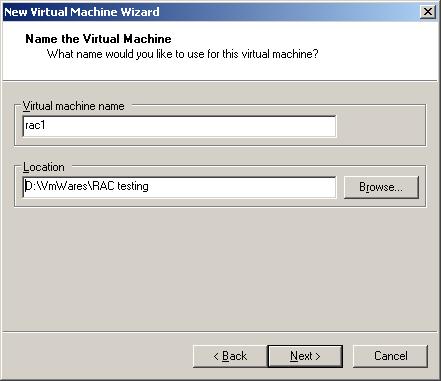
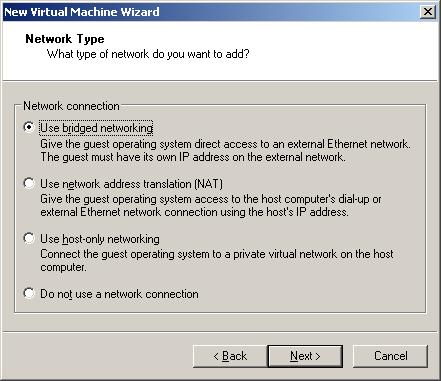

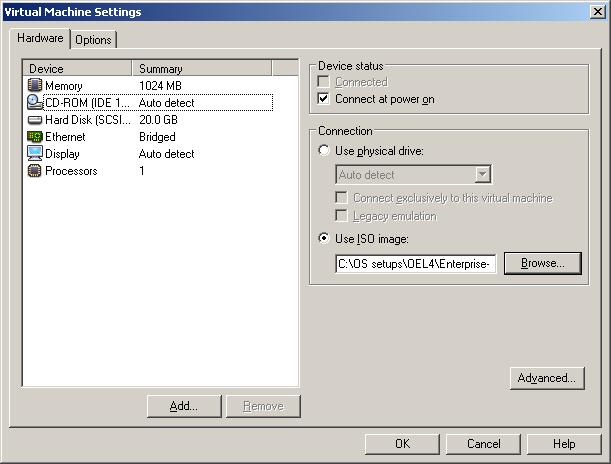


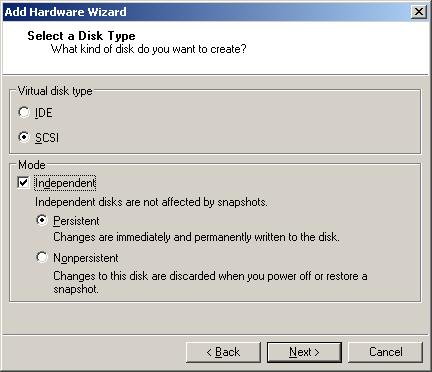






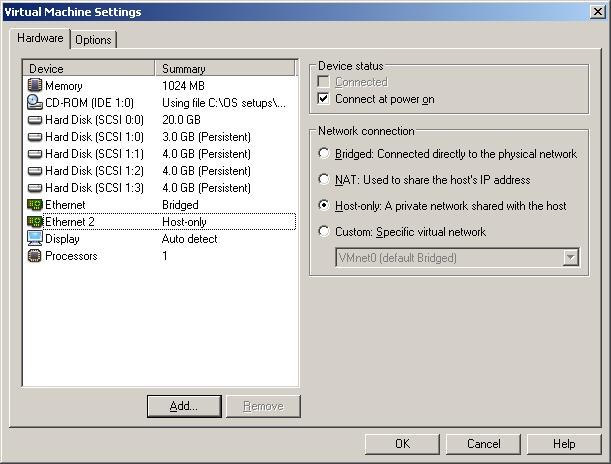
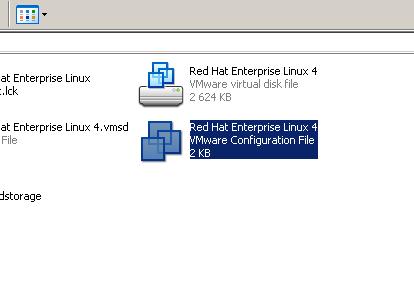







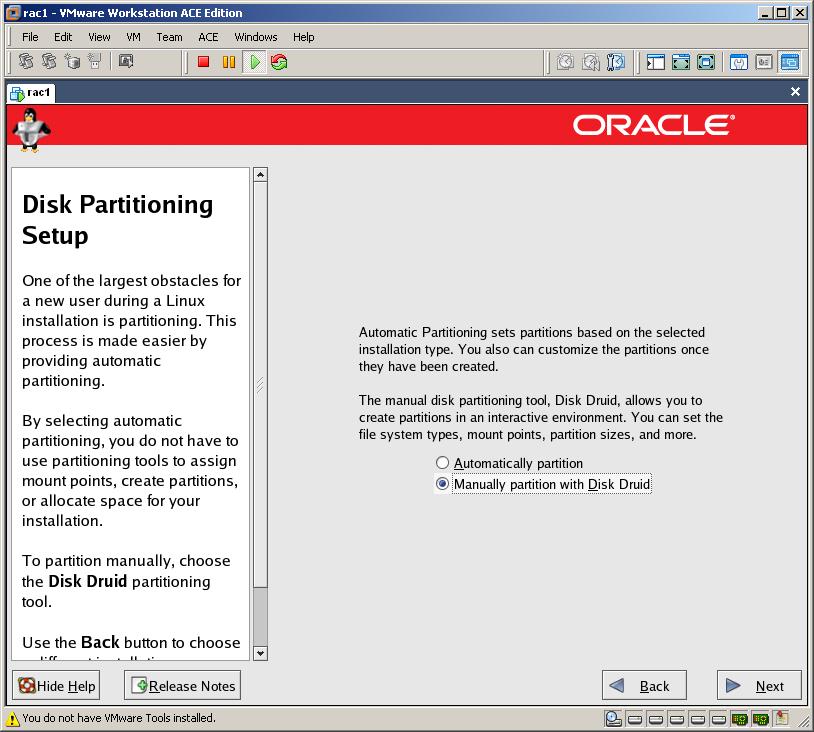
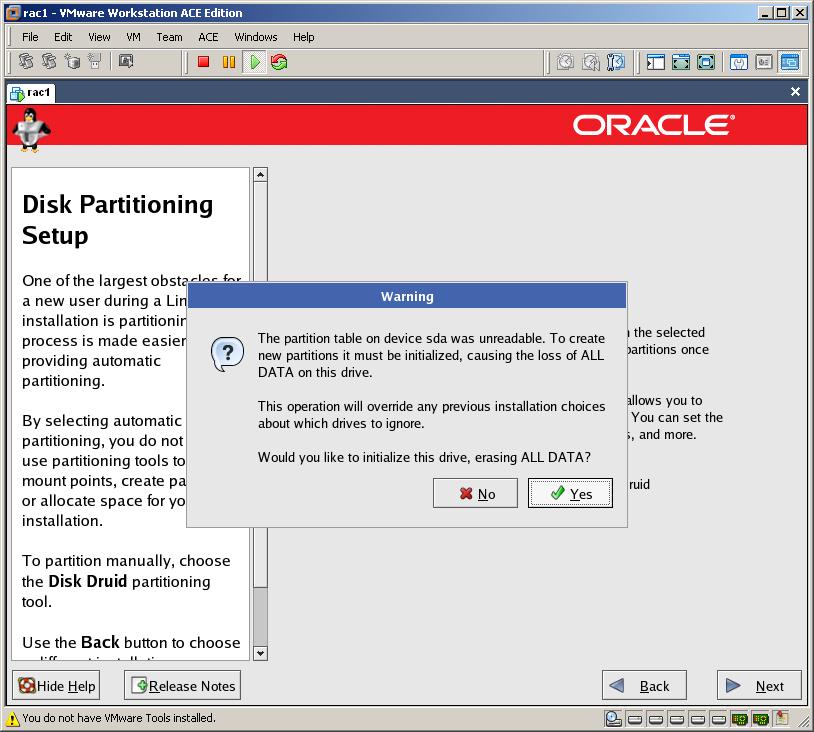


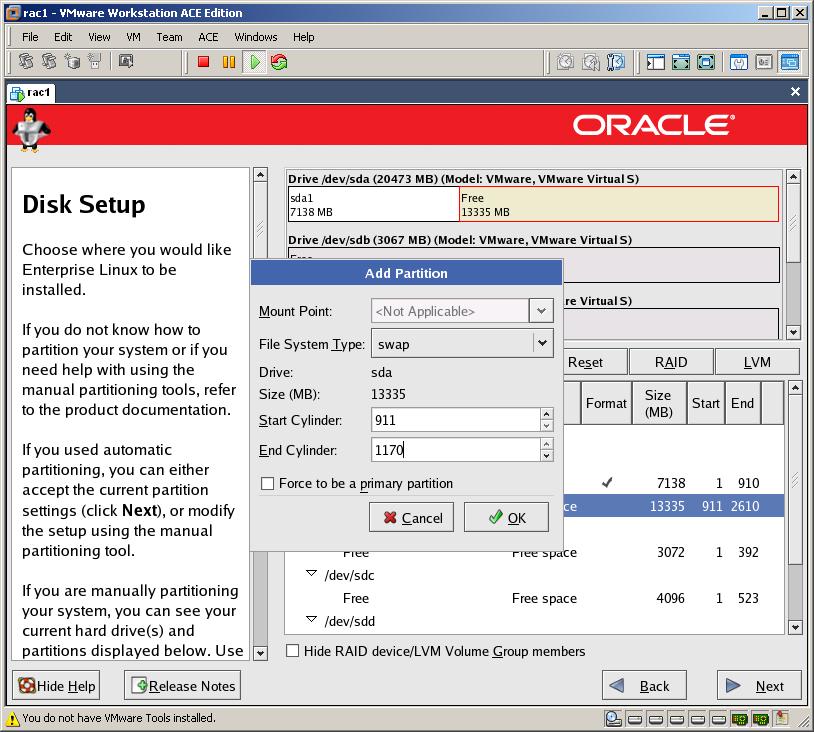





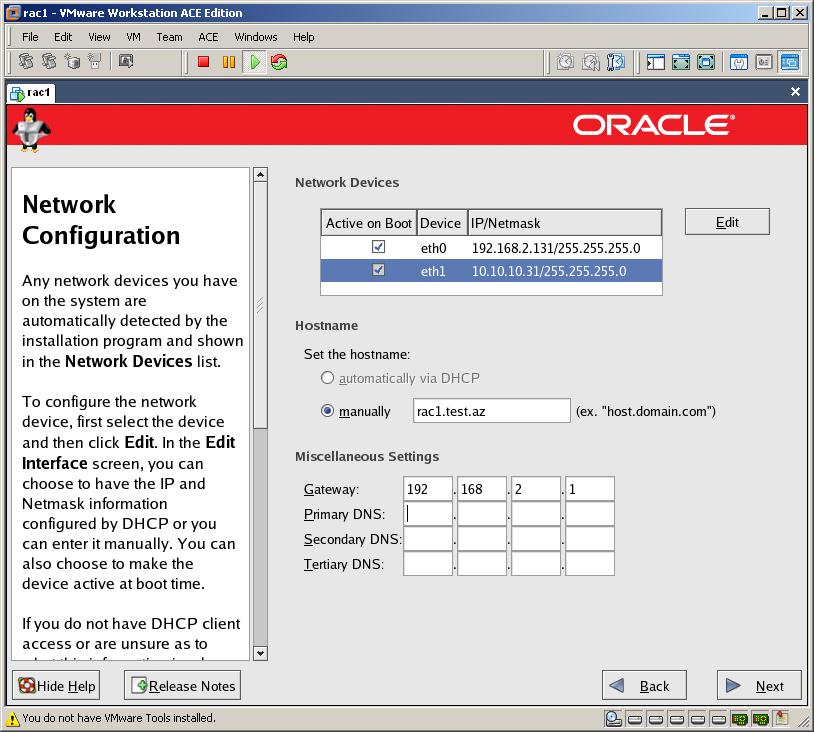


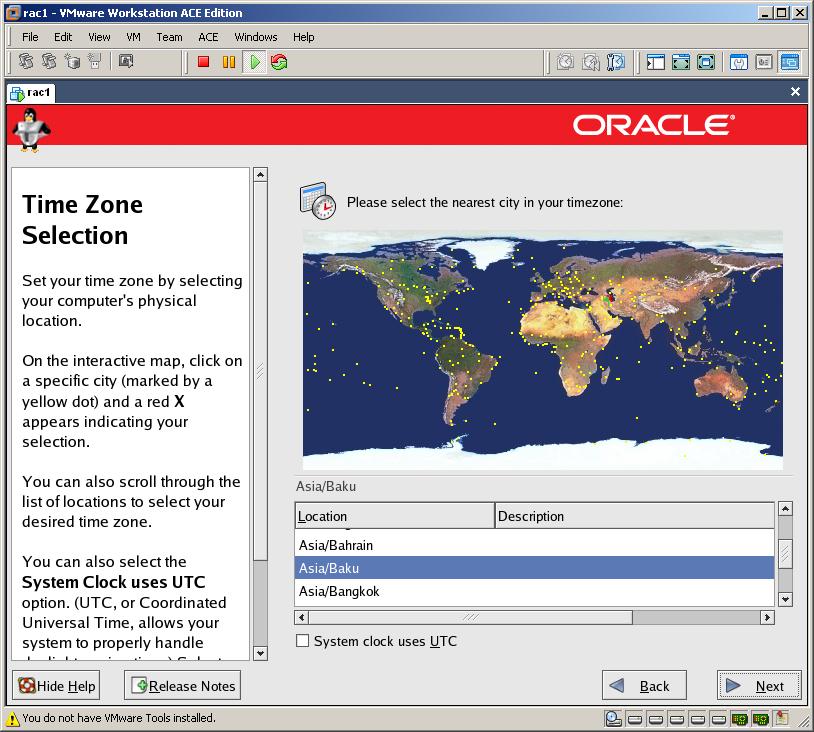






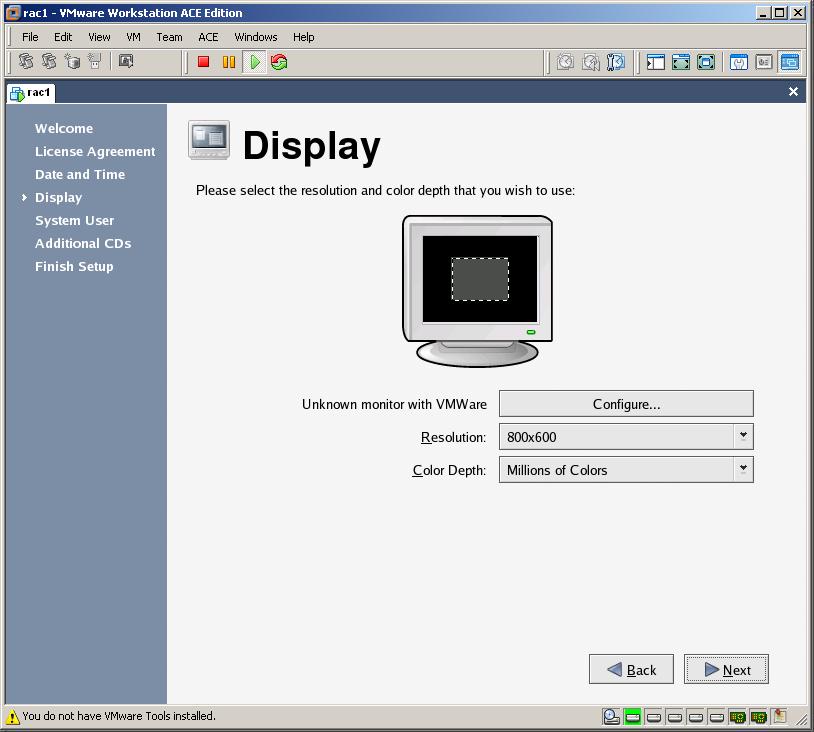

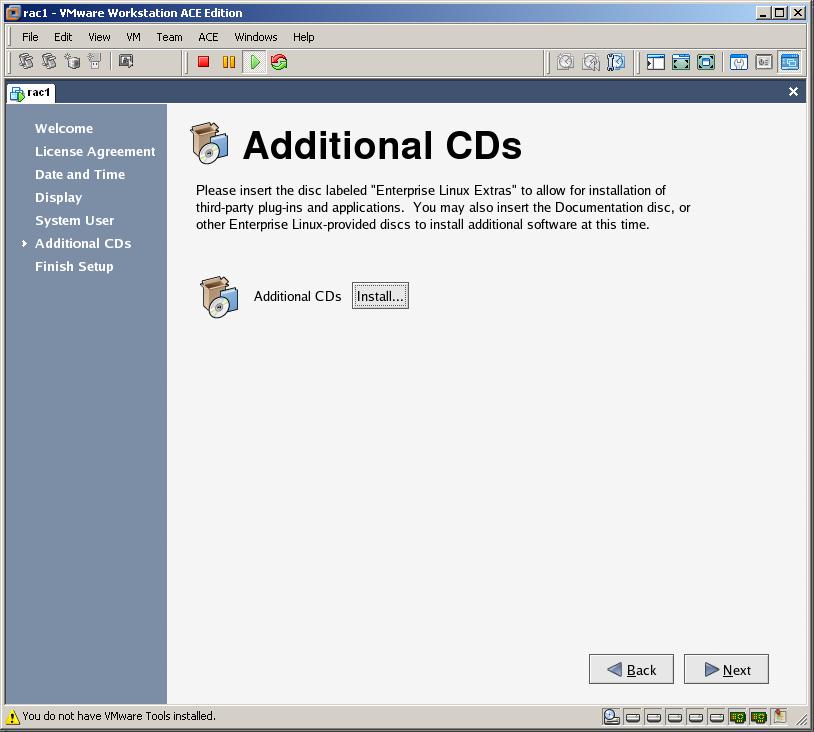
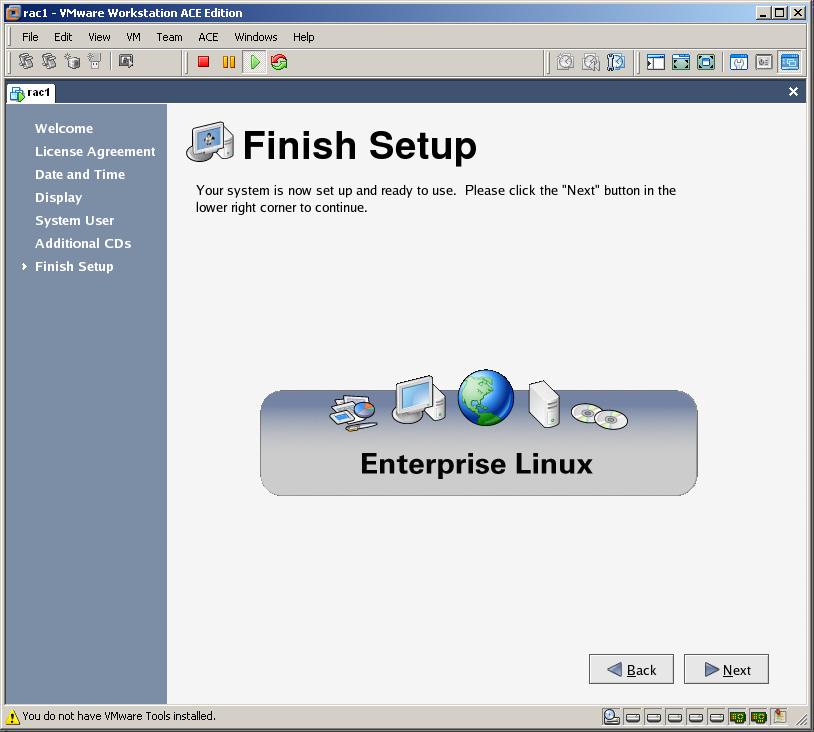










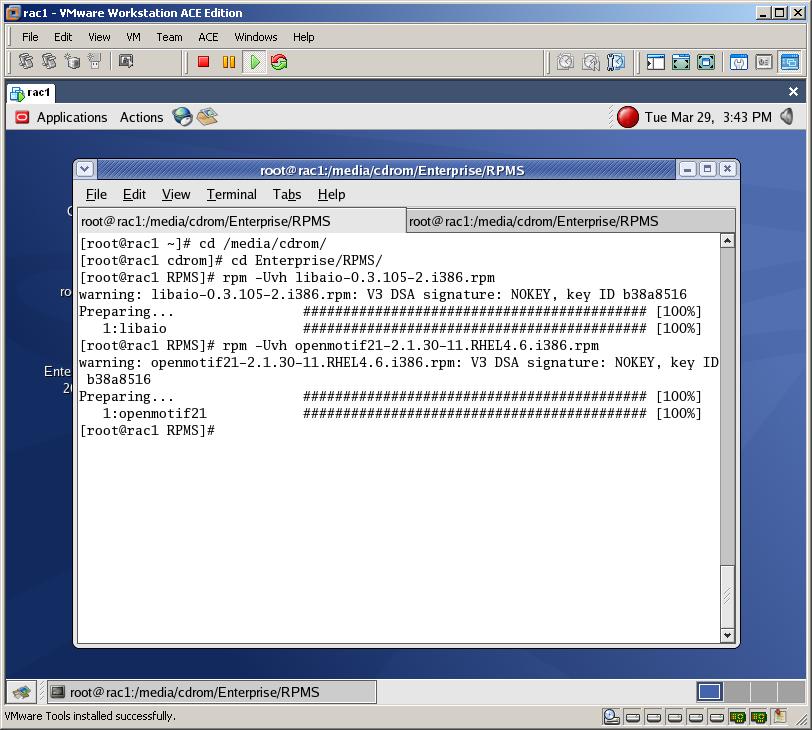




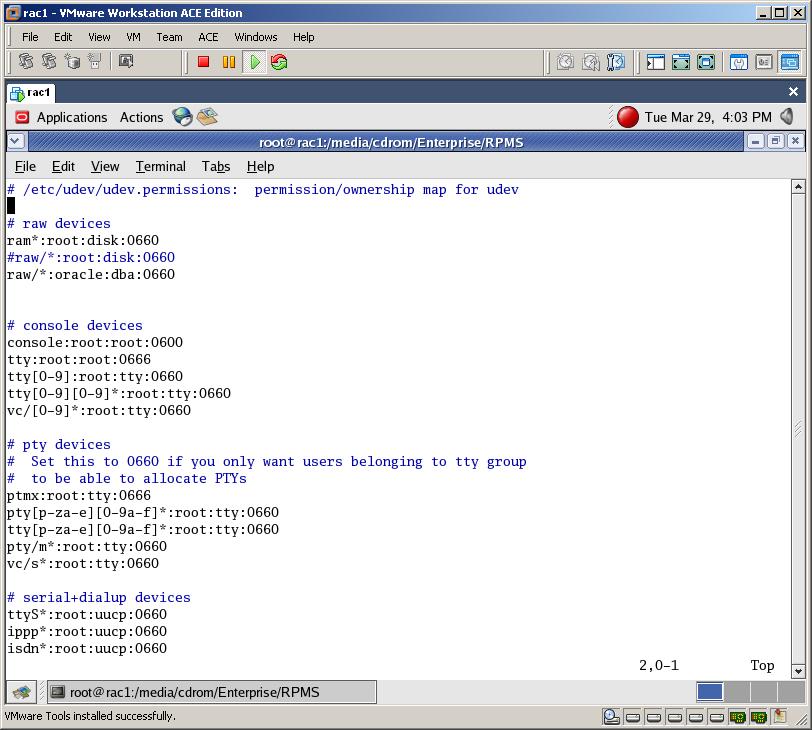






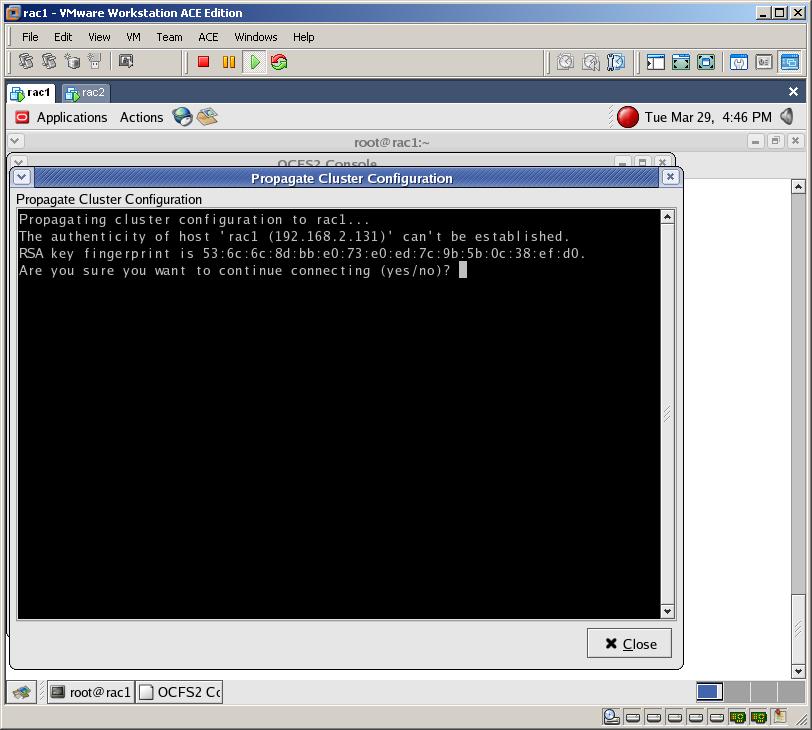

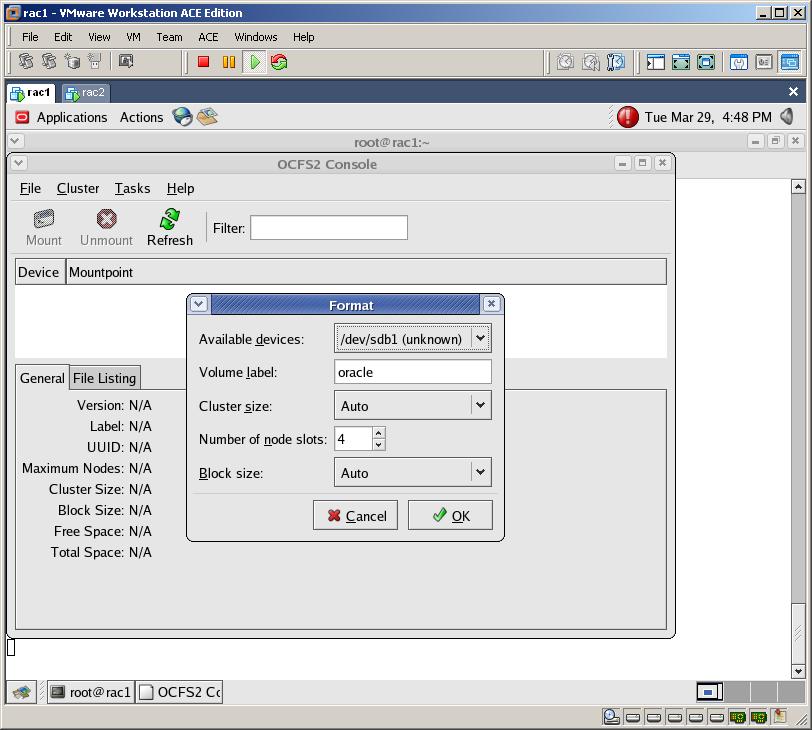


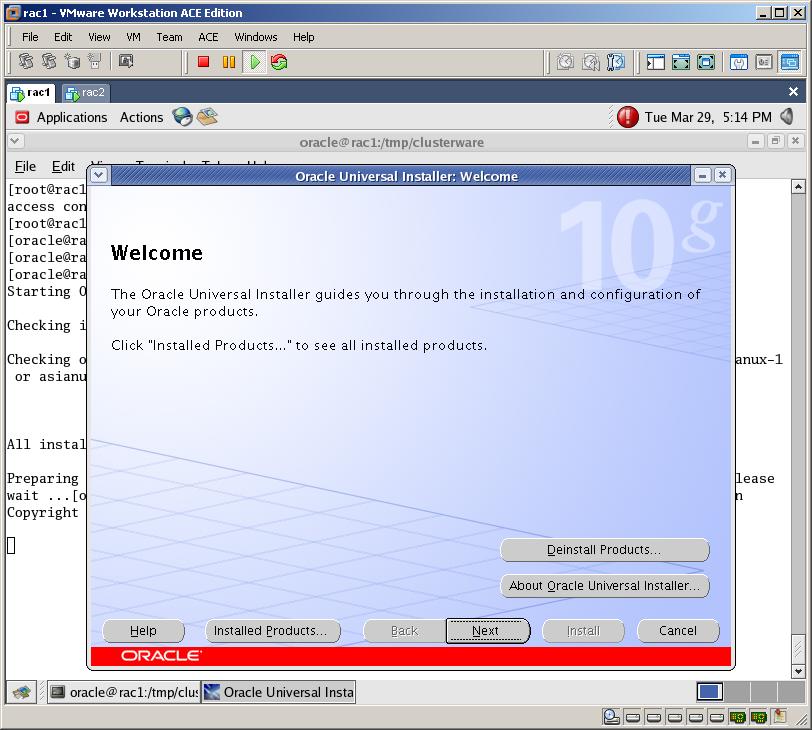
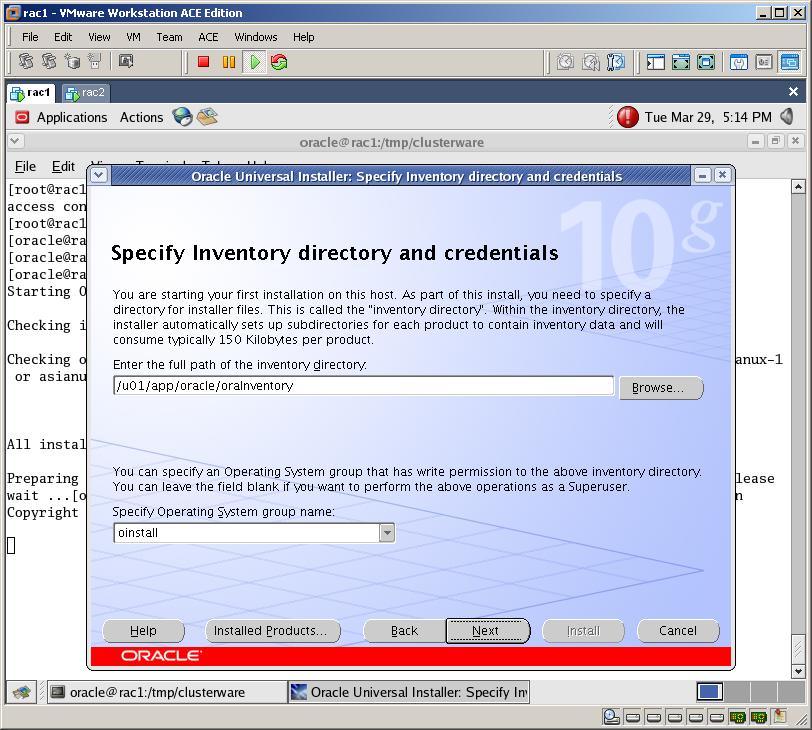

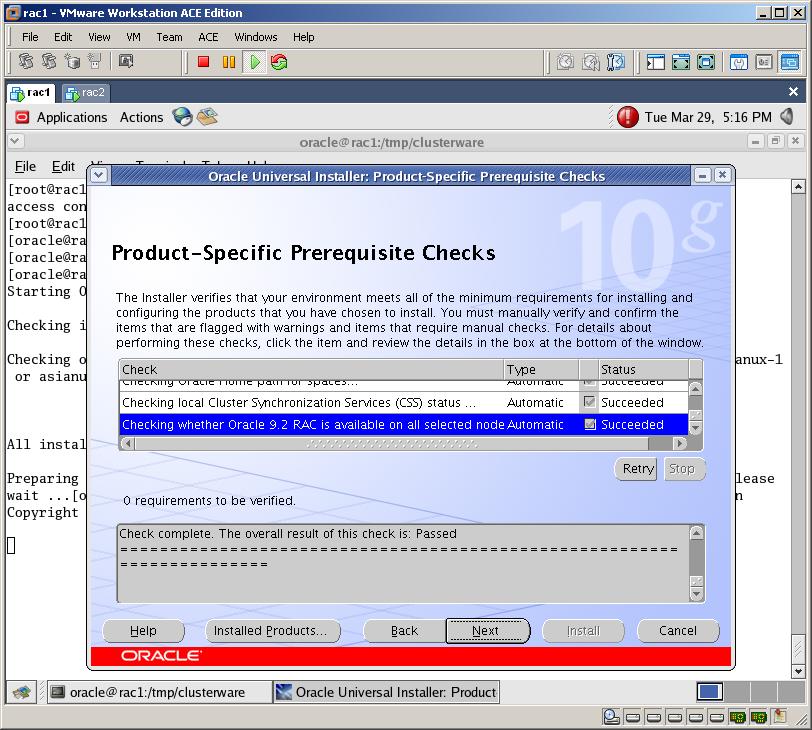


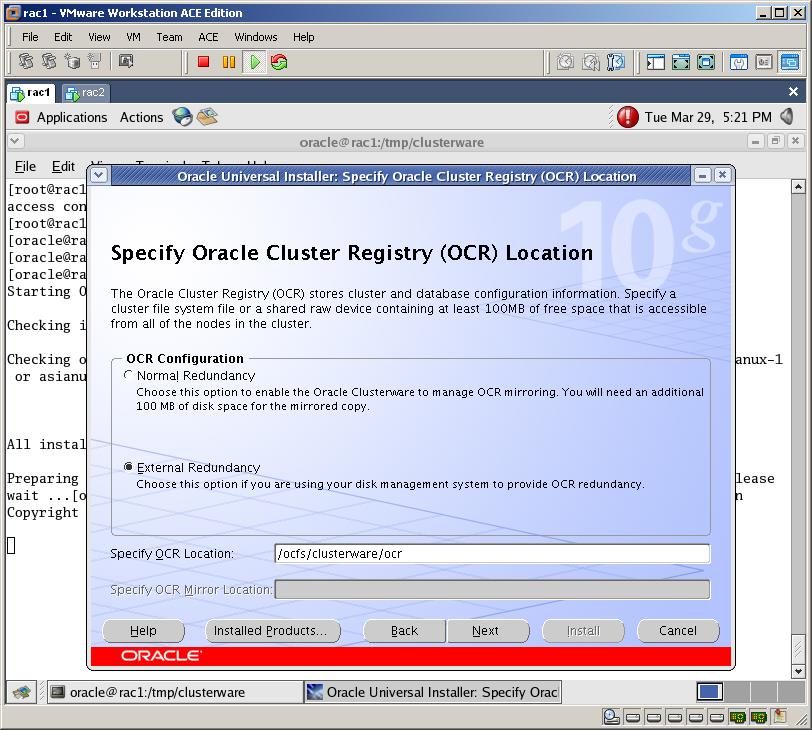


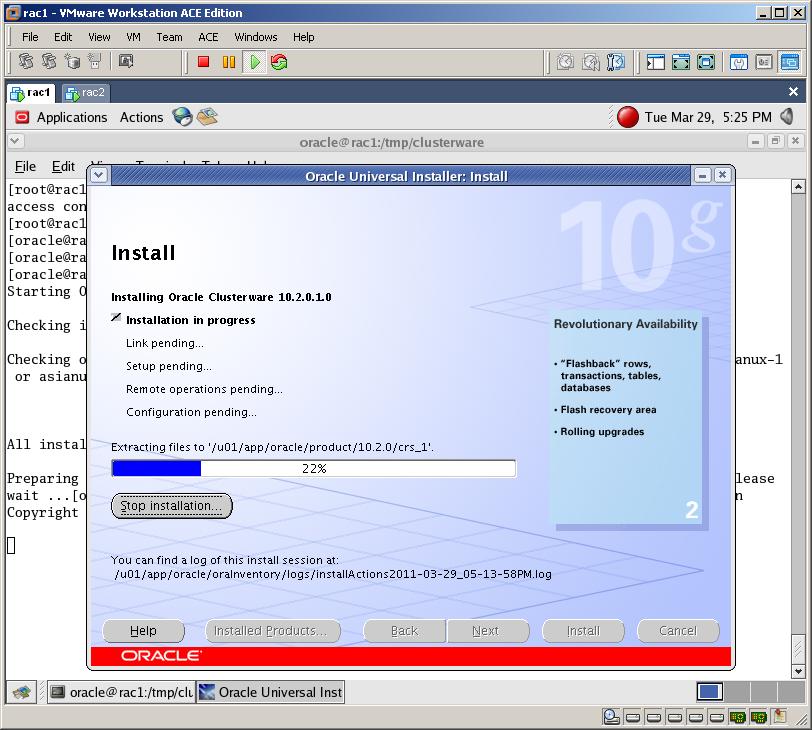



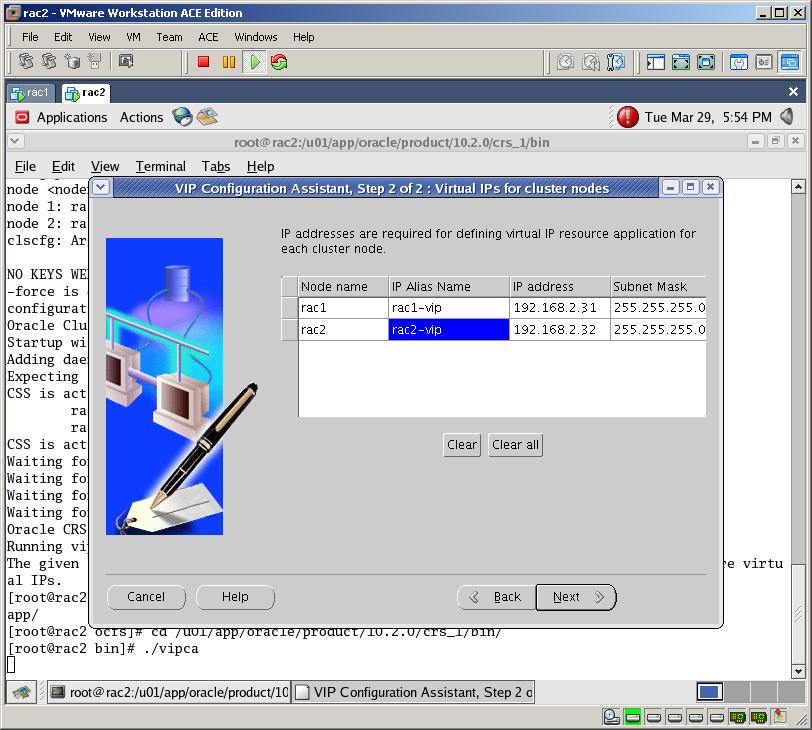
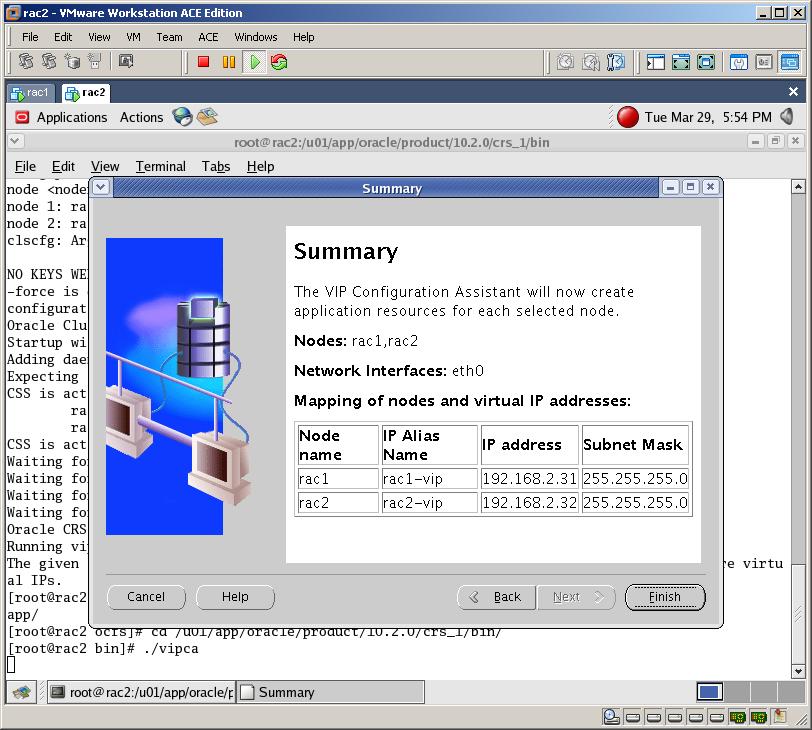

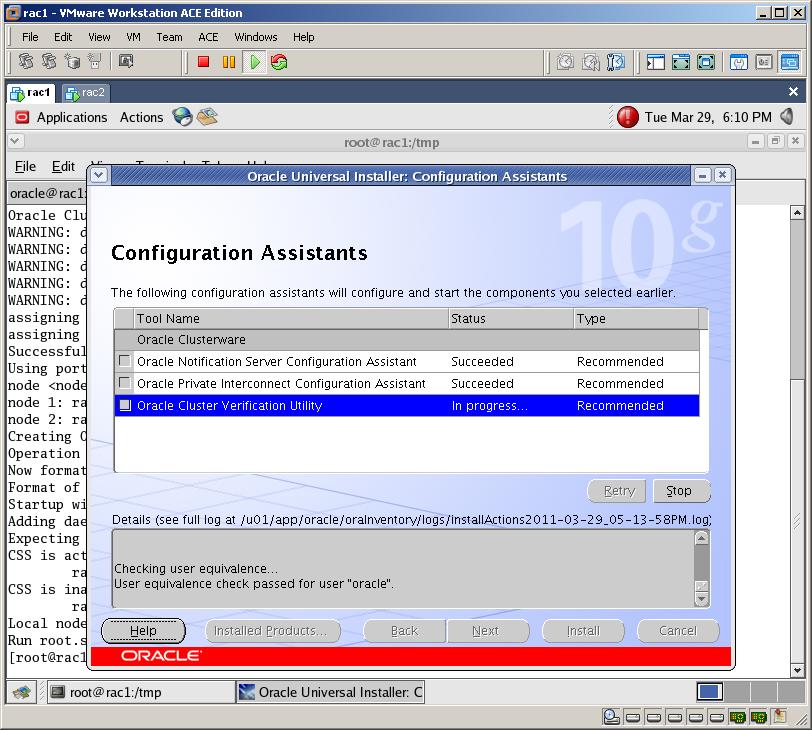
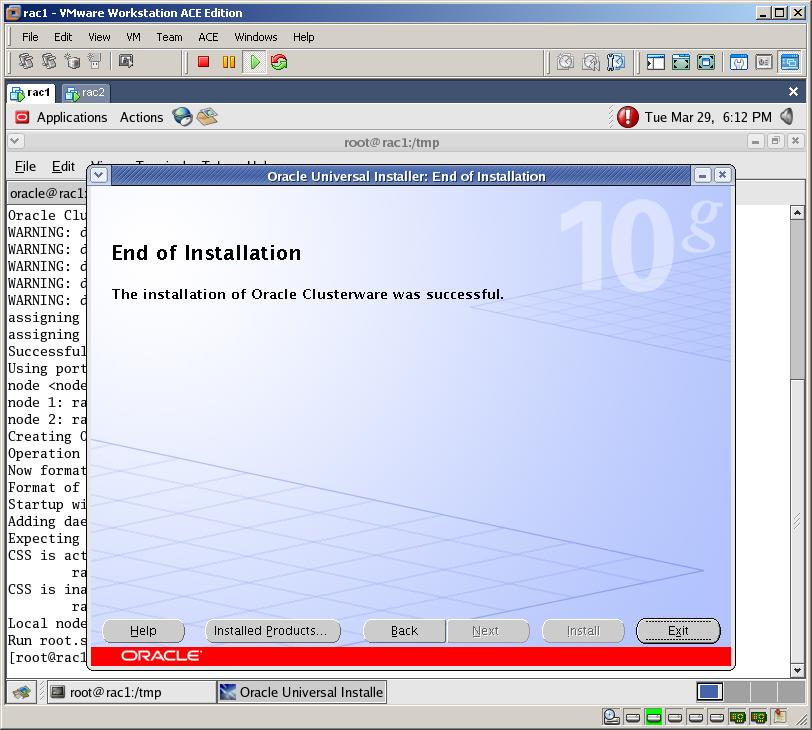


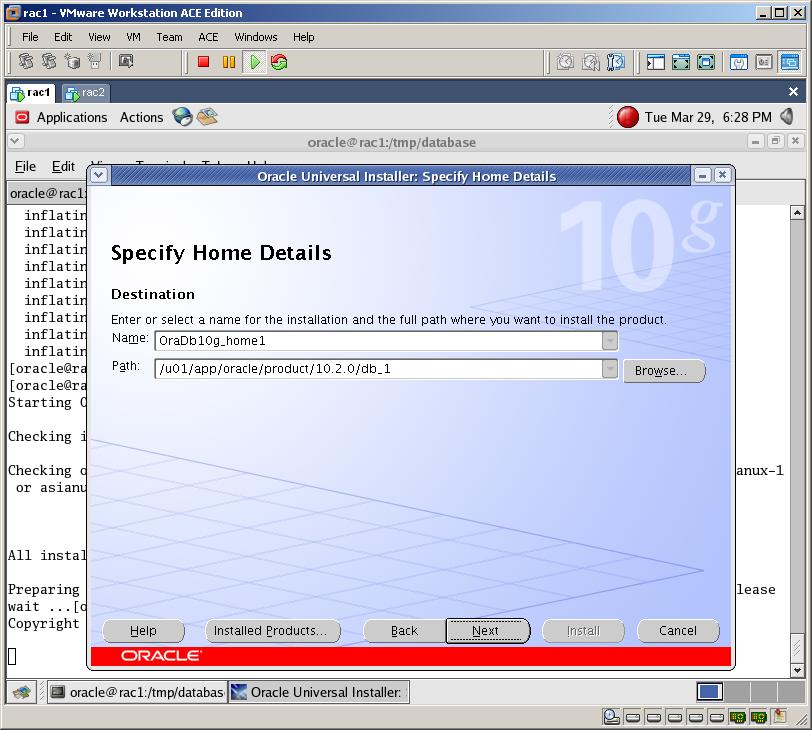






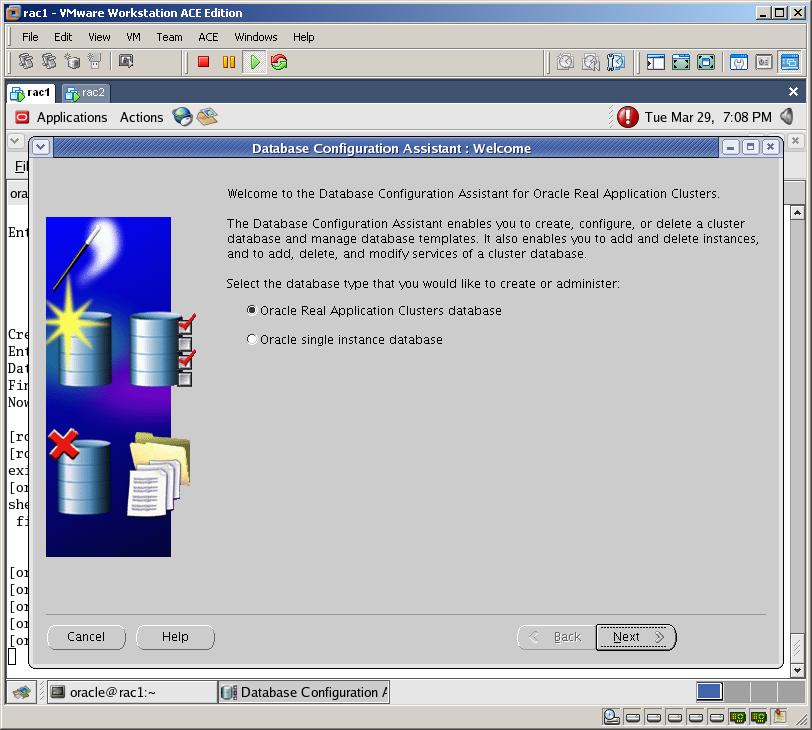
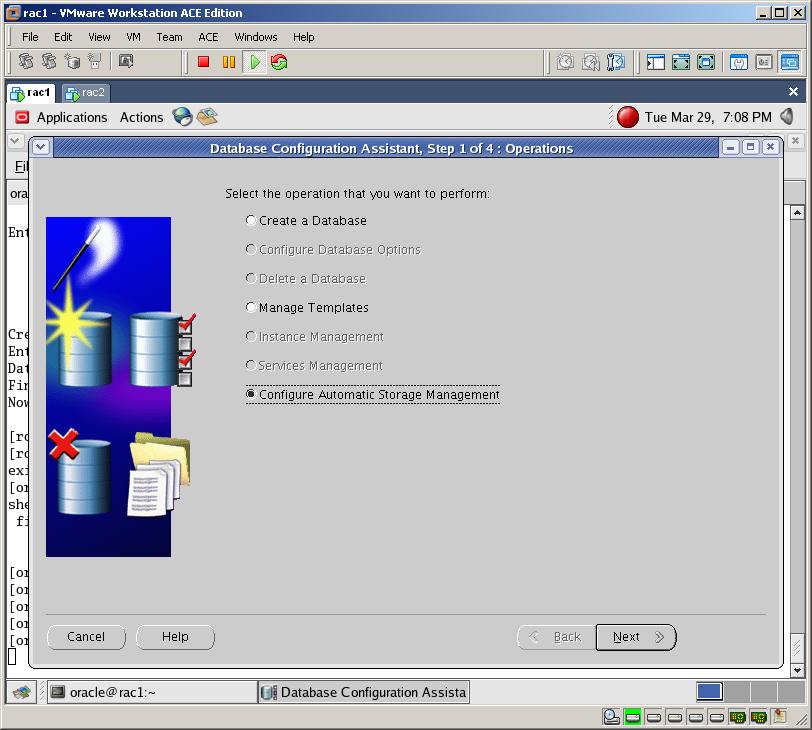






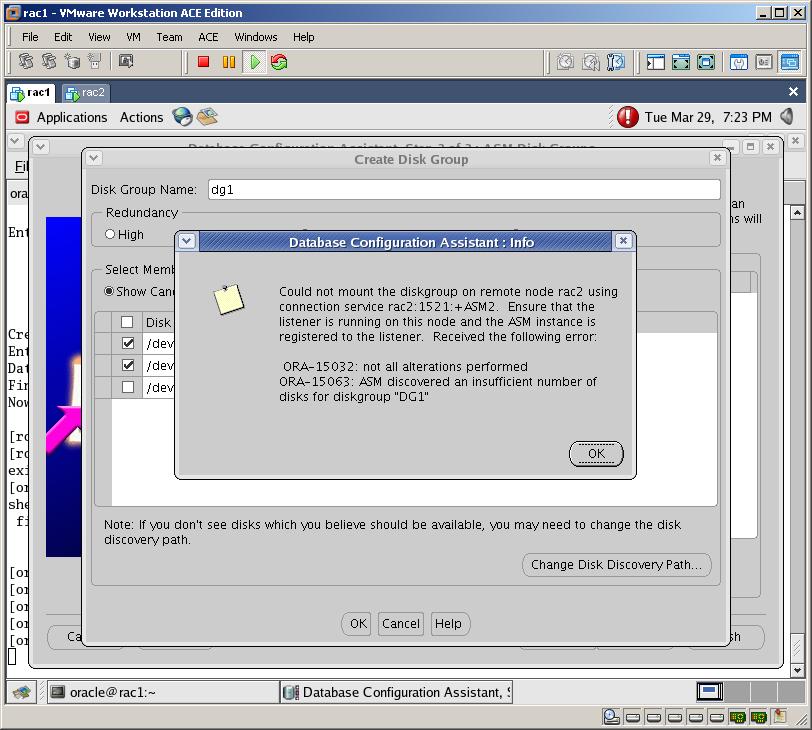
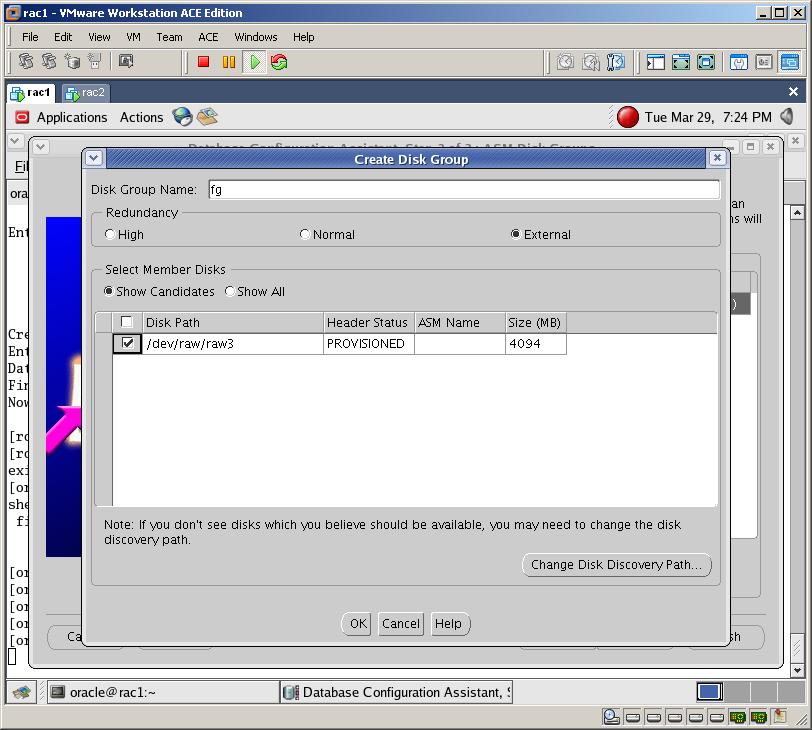

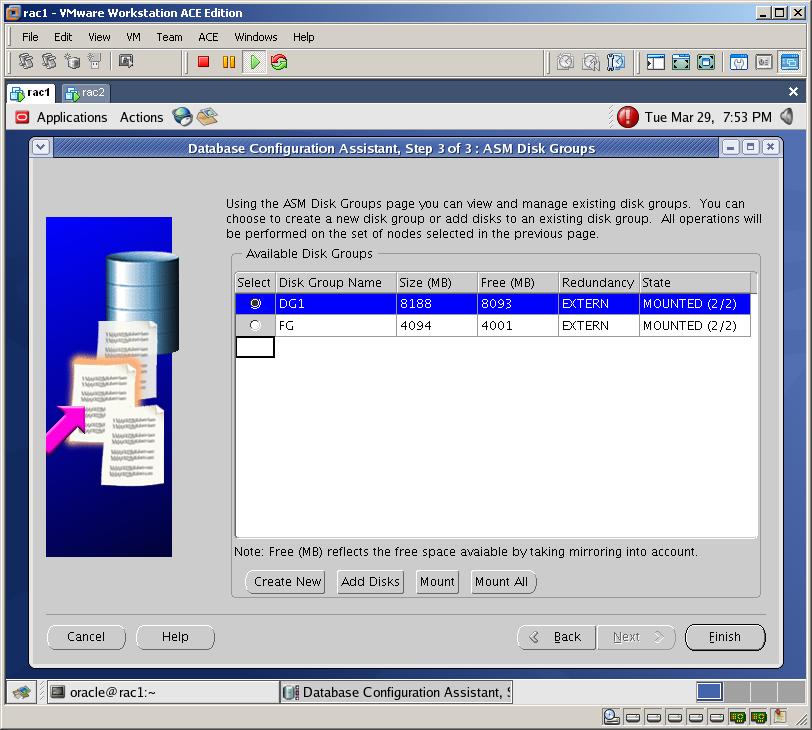







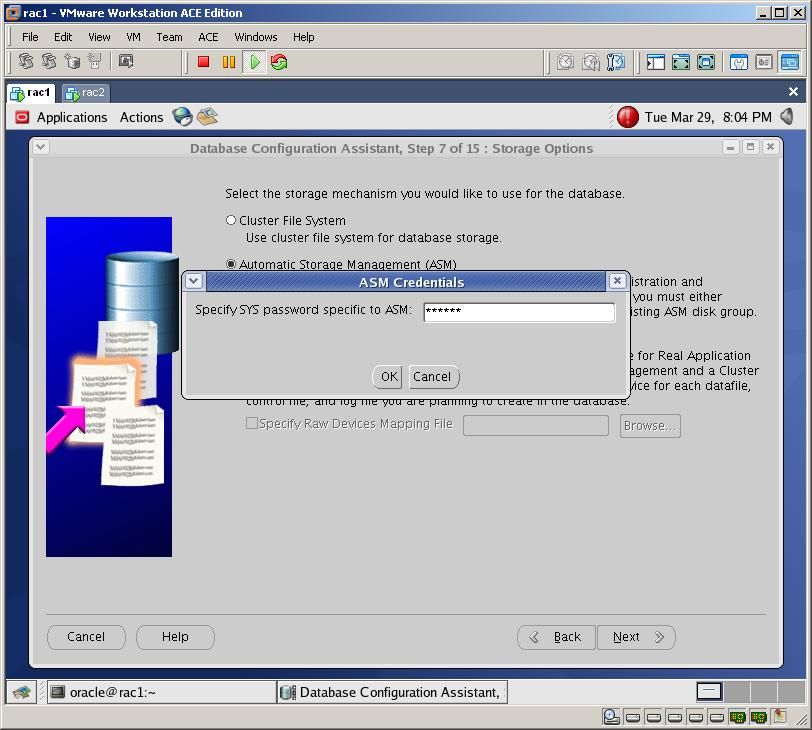






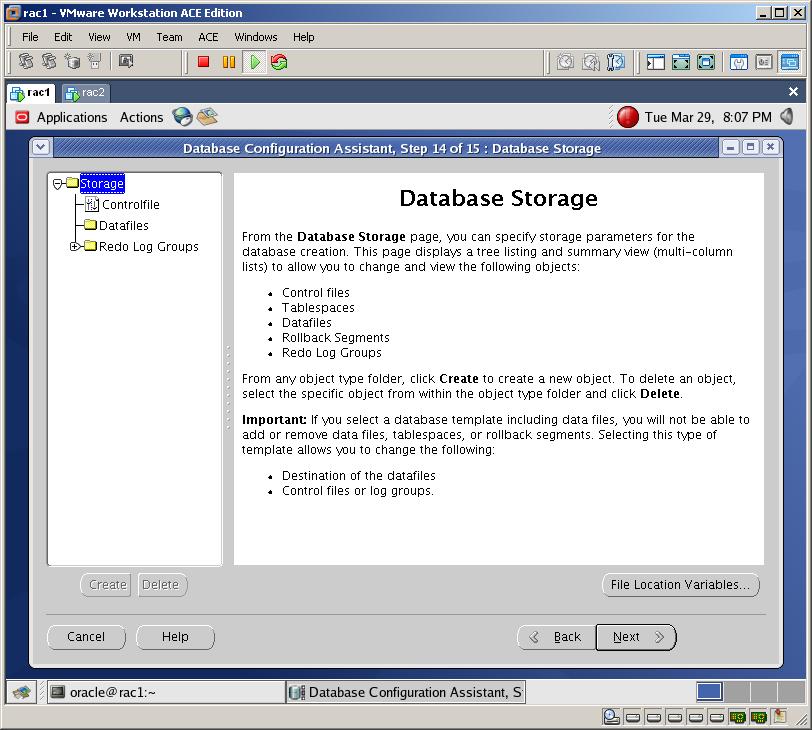




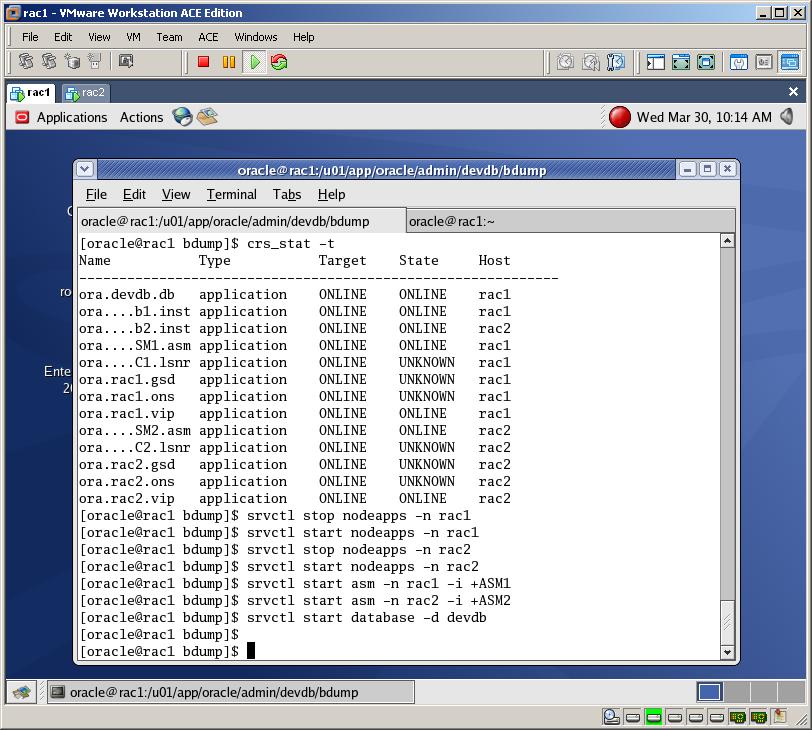

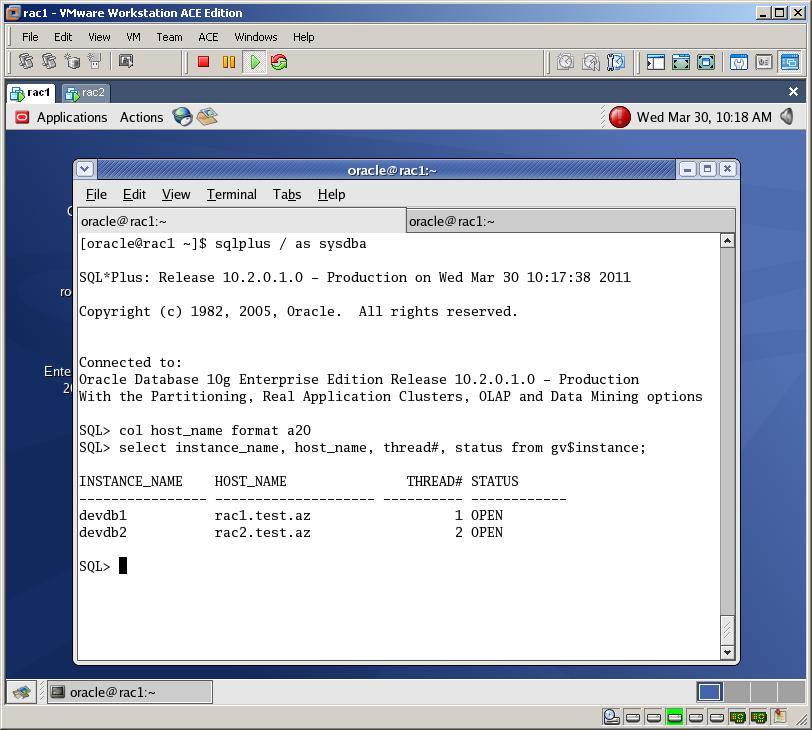
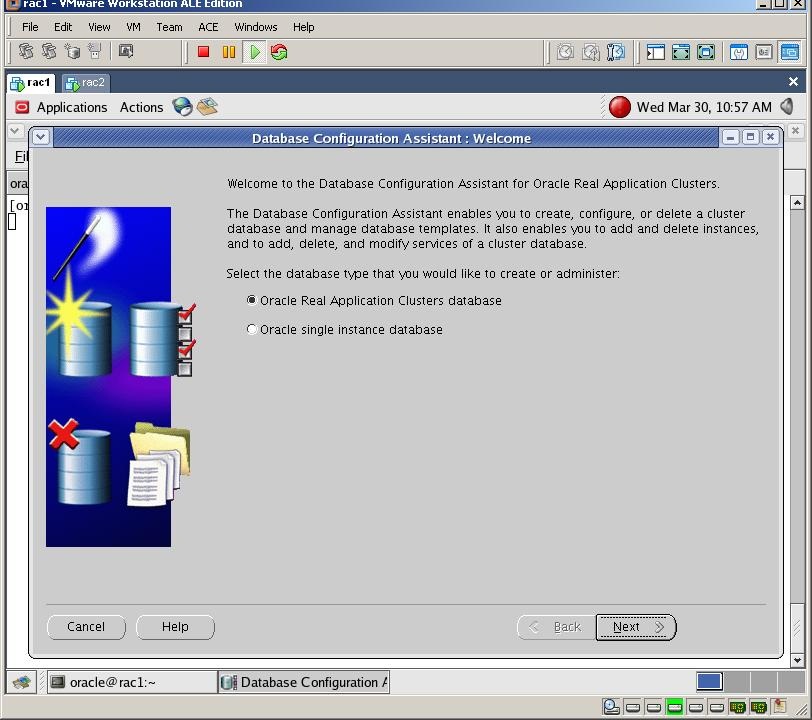

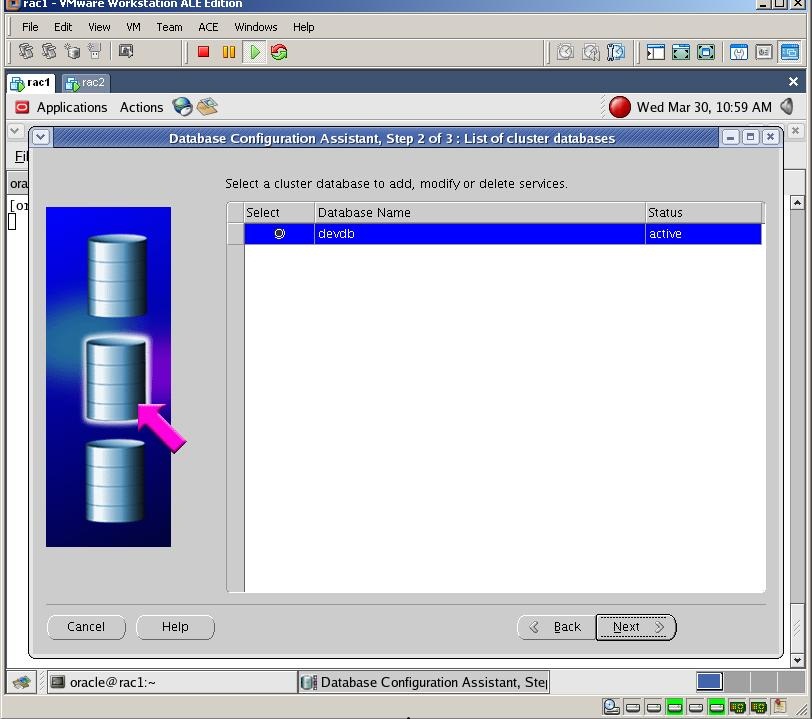




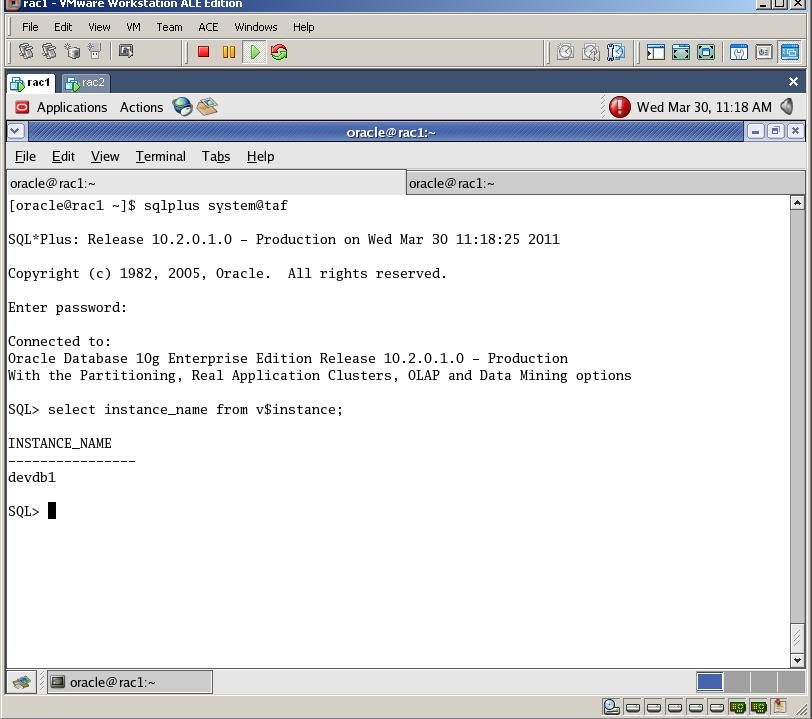


Wissem said
Thanks Brother, Really Useful 🙂
Cheers,
Wissem
Muhammad Adnan said
really Excellent Work Kamran….
Muhammad Adnan said
i m vmworkstation 7 on windows 7
after changing the configuration file (VMX) for Locking / caching option, VM give message (Clustering is not supported)
Muhammad Adnan said
i m using vmworkstation 7 on windows 7 ,
after changing the configuration file (VMX) for Locking / caching option, VM give message (Clustering is not supported)
Mohamed Azar said
Awesome… Appreciate your hard work !!!
Mohamed Azar.
Kamran Agayev A. said
Dear Muhammad Adnan, you can safely ignore that warning and continue the installation
Sheyda Parviz said
Təşəkkürlər, bunu çoxdan axtarırdım.
ASHIK said
masha allah, nice work… can we use the same method 11g versions…
Elkhan Yusubov said
Really nice work, Thanks Kamran !
Keep up this valuable work for ORACLE community !
Vips said
Thanks Kamran!!! It is very useful document.
Do you have same doc in pdf format?
pratap said
Great Job .. Thanks a lot .. Kamran !
Please share your mail ld ..
Kamran Agayev A. said
Check the following link:
Amin Anwar said
Good job !!!!
Muzammil said
Thanks Kamran you have done a good job specially for new enters.
Amins Khan said
Dear Mr. Kamran,
Thanks alot for sharing such a nice tutorial. I have been waiting for RAC for so long.
Can we use the same method with 11g versions. Please let me know.
Kamran Agayev A. said
Dear Amis, thanks for feedback
No, in 11g it’s different, I’ll try to put an article on 11g as well 🙂
Step by Step installing Oracle 10g RAC on VMware (via Kamran Agayev’s Oracle Blog) | 我的幸福生活 said
[…] In this guide I’m going to show you the process of creating Oracle 10g R2 RAC on OEL4. First of all I have to mention that I've prepared this guide based on the well known RAC on VMWare guide of for Vincent Chan which can be found at OTN. After using that guide I've decided to create a more screenshot based explained guide and prepared this blog post which contains 150 screenshots! These days wordpress.com is working veeeeery slowly, so it too … Read More […]
rajiv said
Hi kamran,
Good work – but details about software download for linux to be used is missing(centos,rhel etc).I downloaded oel4 but screens am getting are different than yours. can u tell me as which unix are u using here?
Thanks
Rajiv
Iss said
Hi kamran,
im not able able to ping the rac2 machine. im getting destination host unreachable
this what i have on both /etc/hosts file
127.0.0.1 localhost
192.168.2.131 rac1.test.ca rac1
192.168.2.31 rac1-vip.test.ca rac1-vip
10.10.10.31 rac1-priv.test.ca rac1-priv
192.168.2.132 rac2.test.ca rac2
192.168.2.32 rac2-vip.test.ca rac2-vip
10.10.10.32 rac2-priv.test.ca rac2-priv
this is my network settings from the host OS
C:\Users\Administrator>ipconfig
Windows IP Configuration
Ethernet adapter Local Area Connection 2:
Connection-specific DNS Suffix . :
IPv4 Address. . . . . . . . . . . : 169.254.2.2
Subnet Mask . . . . . . . . . . . : 255.255.255.0
Default Gateway . . . . . . . . . :
Wireless LAN adapter Wireless Network Connection:
Connection-specific DNS Suffix . : gateway.2wire.net
Link-local IPv6 Address . . . . . : fe80::f42f:5673:3e63:3c42%14
IPv4 Address. . . . . . . . . . . : 192.168.2.22
Subnet Mask . . . . . . . . . . . : 255.255.255.0
Default Gateway . . . . . . . . . : 192.168.2.1
Ethernet adapter Bluetooth Network Connection:
Media State . . . . . . . . . . . : Media disconnected
Connection-specific DNS Suffix . :
Ethernet adapter Local Area Connection:
Media State . . . . . . . . . . . : Media disconnected
Connection-specific DNS Suffix . :
Ethernet adapter VMware Network Adapter VMnet1:
Connection-specific DNS Suffix . :
Link-local IPv6 Address . . . . . : fe80::f5f4:c6cf:1a9a:83b9%19
IPv4 Address. . . . . . . . . . . : 192.168.65.1
Subnet Mask . . . . . . . . . . . : 255.255.255.0
Default Gateway . . . . . . . . . :
Ethernet adapter VMware Network Adapter VMnet8:
Connection-specific DNS Suffix . :
Link-local IPv6 Address . . . . . : fe80::4d71:e31c:3448:77a5%20
IPv4 Address. . . . . . . . . . . : 192.168.183.1
Subnet Mask . . . . . . . . . . . : 255.255.255.0
Default Gateway . . . . . . . . . :
Tunnel adapter isatap.{81D569CB-A721-4718-881B-F1B45A0F4E08}:
Media State . . . . . . . . . . . : Media disconnected
Connection-specific DNS Suffix . :
Tunnel adapter isatap.{A0316E71-53CD-4AB8-B35F-DDDD66EDDA8A}:
Media State . . . . . . . . . . . : Media disconnected
Connection-specific DNS Suffix . :
Tunnel adapter Teredo Tunneling Pseudo-Interface:
Connection-specific DNS Suffix . :
IPv6 Address. . . . . . . . . . . : 2001:0:4137:9e76:2067:deb:3f57:fde9
Link-local IPv6 Address . . . . . : fe80::2067:deb:3f57:fde9%15
Default Gateway . . . . . . . . . : ::
Tunnel adapter isatap.{24B7D0DB-9097-4AC3-91EA-C92E6350F04E}:
Media State . . . . . . . . . . . : Media disconnected
Connection-specific DNS Suffix . :
C:\Users\Administrator>
Pedro Miguel said
Great job, i’m working with some projects in cloud and them uses vmware, i already had everything prepared for EBS whithout RAC and now i’ll start the same work with RAC so this article will gona help me too much, my thx…
Kamran Agayev A. said
Dear ISS
Have you done all steps as it’s shown in the screenshots? The first ethernet device should be “Bridged” and the second should be “Host only”
moreover, you need to start them both
Iss said
Hi kamran,
I started again all from scratch. I may have got up mixed with the virtual machine copy and ip addresses i can ping now.
Thanks
olaf said
cool, i learn a lot
many thanks to kamranagayev
aamir hussain said
Excellent! Its very helpful. You have done a wonderfull job for Us. Thanks
Iss said
Hi kamran,
Will you also do tutorial on migration fron non rac to rac or from non asm to asm or any other combination
Thank you.
Satiram qrubu said
wonderful
shankarreddy said
Hi Kamran,
Your documentation is good
Regards,
Shankar Reddy
Vineet Arya said
Excellent article. Thanks for posting
lalitha said
hi kamaran sir,
i would like to appreciate your great job. this is amazing. Greteful to your hardwoek done here.Thank you soo much for providing a useful valuable doc .
i’m using vmwareworkstaton 7 in windows 7, but after creating rac1 vmmachine, wen i tried to install RedHat linux 4 version..the slides are not same sa here ..meaning DHCP seetings (network settings).I’m afraid to move ahead. i don’t have Oracle Enterprise Linux..am using RedHat Linux 4.
Appreciate you could say is it okay to move.
Jerry said
All good until I get to the ASM and OCFS2 setup section.
Neither oracleasm nor ocfs2console exist in the OEL4 VM. Is there an installation section missing or have I missed a step?
Kamran Agayev A. said
Dear Jerry
You have to install it during OS installation
Kamran Agayev A. said
Dear Lalitha, please download OEL 4 and perform your test on that OS
Anup A. uplenchwar said
Hi,
Kamran
Thanks bro its really toooo goood….
Again thanks!! for u r great supprot ..
M. Imran said
Hi Kamra,
A good article for newbies.
I am using OLE 4 on vmware 6 workstation but unable to mount OCFS2 shared drive on second node. Any help will be appreciated.
Kamran Agayev A. said
Dear Imran
Could you please post what error you get?
M. Imran said
Dear Kamran,
How I can check that my OLE 4.8 vmware is sharing disks.
I have fallowed the steps carefully but my OCFS2 disk not mount at second node, I can’t see it on second node after mounting it successfully on node1 (server of ocfs)
I check /etc/ocfs2/cluster.conf that is properly formatted and when I check status of o2cb it shows me Active heartbeat at node1 only.
I am using vmware 7 workstation, my vmx file is as fallows. I am great-full for you help.
.encoding = “windows-1252”
config.version = “8”
virtualHW.version = “7”
scsi0.present = “TRUE”
scsi0.virtualDev = “lsilogic”
memsize = “1024”
scsi0:0.present = “TRUE”
scsi0:0.fileName = “boot_linux.vmdk”
ide1:0.present = “TRUE”
ide1:0.fileName = “C:\Program Files\VMware\VMware Workstation\linux.iso”
ide1:0.deviceType = “cdrom-image”
floppy0.startConnected = “FALSE”
floppy0.fileName = “”
floppy0.autodetect = “TRUE”
ethernet0.present = “TRUE”
ethernet0.wakeOnPcktRcv = “FALSE”
ethernet0.addressType = “generated”
usb.present = “TRUE”
ehci.present = “TRUE”
sound.present = “TRUE”
sound.fileName = “-1”
sound.autodetect = “TRUE”
serial0.present = “TRUE”
serial0.fileType = “thinprint”
pciBridge0.present = “TRUE”
pciBridge4.present = “TRUE”
pciBridge4.virtualDev = “pcieRootPort”
pciBridge4.functions = “8”
pciBridge5.present = “TRUE”
pciBridge5.virtualDev = “pcieRootPort”
pciBridge5.functions = “8”
pciBridge6.present = “TRUE”
pciBridge6.virtualDev = “pcieRootPort”
pciBridge6.functions = “8”
pciBridge7.present = “TRUE”
pciBridge7.virtualDev = “pcieRootPort”
pciBridge7.functions = “8”
vmci0.present = “TRUE”
roamingVM.exitBehavior = “go”
displayName = “node1”
guestOS = “oraclelinux”
nvram = “Oracle Enterprise Linux.nvram”
virtualHW.productCompatibility = “hosted”
printers.enabled = “TRUE”
extendedConfigFile = “Oracle Enterprise Linux.vmxf”
ethernet0.generatedAddress = “00:0c:29:d6:b5:40”
tools.syncTime = “TRUE”
uuid.location = “56 4d 3d 26 e2 2e e0 18-34 10 06 cb 18 d6 b5 40”
uuid.bios = “56 4d 3d 26 e2 2e e0 18-34 10 06 cb 18 d6 b5 40”
cleanShutdown = “FALSE”
replay.supported = “TRUE”
replay.filename = “”
scsi0:0.redo = “”
pciBridge0.pciSlotNumber = “17”
pciBridge4.pciSlotNumber = “21”
pciBridge5.pciSlotNumber = “22”
pciBridge6.pciSlotNumber = “23”
pciBridge7.pciSlotNumber = “24”
scsi0.pciSlotNumber = “16”
usb.pciSlotNumber = “32”
ethernet0.pciSlotNumber = “33”
sound.pciSlotNumber = “34”
ehci.pciSlotNumber = “35”
vmci0.pciSlotNumber = “36”
vmotion.checkpointFBSize = “16777216”
ethernet0.generatedAddressOffset = “0”
vmci0.id = “416724289”
tools.remindInstall = “FALSE”
ethernet0.connectionType = “bridged”
disk.locking=”FALSE”
diskLib.dataCacheMaxSize= “0”
scsi0.sharedBus =”virtual”
scsi0:1.deviceType= “disk”
scsi0:1.present = “TRUE”
scsi0:1.fileName = “asm1.vmdk”
scsi0:1.mode = “independent-persistent”
scsi0:2.deviceType= “disk”
scsi0:2.present = “TRUE”
scsi0:2.fileName = “asm2.vmdk”
scsi0:2.mode = “independent-persistent”
scsi0:3.deviceType= “disk”
scsi0:3.present = “TRUE”
scsi0:3.fileName = “asm3.vmdk”
scsi0:3.mode = “independent-persistent”
scsi0:4.deviceType= “disk”
scsi0:4.present = “TRUE”
scsi0:4.fileName = “ocr.vmdk”
scsi0:4.mode = “independent-persistent”
ethernet1.present = “TRUE”
ethernet1.connectionType = “hostonly”
ethernet1.wakeOnPcktRcv = “FALSE”
ethernet1.addressType = “generated”
ethernet1.generatedAddress = “00:0c:29:d6:b5:4a”
scsi0:1.redo = “”
scsi0:2.redo = “”
scsi0:3.redo = “”
scsi0:4.redo = “”
ethernet1.pciSlotNumber = “37”
ethernet1.generatedAddressOffset = “10”
ide1:0.startConnected = “FALSE”
unity.wasCapable = “FALSE”
babu said
Can i install & implement this configuration on OEL 5? or i need only OEL 4?
Kamran Agayev A. said
Dear Babu
Yes you can, but you need to perform some prerequisites as OEL 4 is not supported with Oracle 10gR2 RAC
Deepika said
Hi,
Sir is that to implement RAC we require dual core processor …..
Sir could u please mention the details of hardware
Best Regards
Deepika
bhavan said
Great work man….
Kamran Agayev A. said
Not it’s not required Deepika
pavan said
Hi,
I am unable to share the /ocfs on 2nd node:
[root@rac2 ~]# mount -t ocfs2 -o datavolume,nointr /dev/sdb1 /ocfs
mount.ocfs2: Bad magic number in superblock while opening device /dev/sdb1
[root@rac2 ~]#
Can you please help out! I will be delighted if you can?
Thanks,
Pavan
M. Imran said
Dear Kamran,
I have tried with different combination to shared disk in VM but no luck. May be my OS or system architecture not supported for that. Then I tried openfiler on VM and it is working great and my two node cluster is flying now. Your blog help me a lot. Will try your all other tutorials.
Thank you very much.
Regards,
Imran
Karthik said
Awesome tutorial….Many thanks Kamran for providing such an useful guide and i appreciate you hard work involved in preparing this tutorial..
Kamran Agayev A. said
Thank you for the feedback Karthik
Deepika said
Hi,
Sir i read step by step i have a query related to vmvware as my using vmware workstation 7.0 and related to partions while installing Sir i wanted to implemented as it is great arcticle but wanted to confirm u wheather the same will work on vmware workstation 7.0 on Oracle Enterprise Linux 5.5
Regards ,
Deepika
Deepika said
Hi,
Sir u have clearly mentioned u are using OLE4 but sir i don’t have ant\y other version as if i change the /etc/redhat-release 5.5 to 4 will that work as in cse of installation of oracle
Regards
Deepika
Kamran Agayev A. said
Dear Deepika
There may be some differences in configuration file of the vmware due to the version difference. And the installation RAC on OEL 5 has some pre-requisites (as it is not certified), so would suggest you to get the correct vmware and OEL (you can download OEL 4 from this link – http://edelivery.oracle.com/linux)
Janis Griffin said
Great documentation on how to set up Oracle on VMware! A great tool to view all of the layers of virtual environment to see how your databases are performing in VM is IgniteVM. You can download a free trial of IgniteVM at http://www.confio.com. IgniteVM will show your Tops Sqls/Waits along with Database Health Metrics, the VM/OS guest layer, Host layer and Storage layer in one screen to help you quickly identify bottlenecks at any of the layers.
Mohammed.Ateeq said
Hi,
i have installed vmware on windows xp. The vmware has Redhat linux AS4 installed.
uname -i = i386
uname -r = 2.6.9-5.EL
I am looking for oracleasm rpm’s related with this Linux OS. Could anyone please help me identify which rpm’s to download. I am facing problem @ this step:
/etc/hosts/oracleasm configure
Initializing the Oracle ASMLib driver: [FAILED]
I tried this website(http://www.oracle.com/technetwork/server-storage/linux/downloads/rhel4-092650.html), but couldn’t the exact RPM’S for my OS.
Please suggest where i can download rpm and their names.
Best Regards,
krishna said
Hi kamran how r u.
where do I find the configuration file of the virtual machine and start editing it.
regards,
krishna.
krishna said
Hi kamran how r u.
when I am double clicking on vmware tools the rpm package file is not appearing. Only .pl is appearing on the screen.
what need to be done
regards,
ramakrishna.
kavita said
Hi,
Sir iam getting stuck at this step when ever i execute
[oracle@rac1 ~]$ ssh-keygen -t rsa
-bash: ssh-keygen: command not found
[oracle@rac1 ~]$
Thanks in Advance
Regards
Kavita
kavita said
Hi ,
Sir while doing the enteries in bash_profile and .bashrc iam facing the above issue iam using ole 4.4
Thanks in Advance
Regards
Kavita
Kamran Agayev A. said
Which issue are you facing when entering to the bash_profile file?
Kamran Agayev A. said
Try one of the following:
/bin/ssh-keygen
/sbin/ssh-keygen
/usr/sbin/ssh-keygen
Kamran Agayev A. said
I’ve already shown where to find the configuration file in the screenshots. Please check the post cearfully
kavita said
Hi,
Sir if do the enteries in bash_profile my user oracel gets corrupt and non of the commands such as man ,pwd and ssh is not working an my termnal gets converted
rac1>
iam using the ole version 4 but still issues of user has arised
Thanks in Advance
Regards
Kavita
rajat said
Hi kamran,
I am getting below error,
ssh rac2 cat ~/.ssh/id_rsa.pub >> ~/.ssh/authorized_keys
ssh:connect to host rac2 port 22:No route to host
Kamran Agayev A. said
Dear Rajat
Have you specified “rac2” in the /etc/hosts table? Are you able to ping it?
rajat said
Hi kamran,
i have mentioned entries in /etc/hosts file in both VM machines.
I’m able to ping locally on remote node but not able to ping rac2 on rac1 machine & vice-verse.
Kindly Suggest.
Regards,
Rajat
ibrahim said
Hi kamran
i have a Error failed..pls help me in this step…
[root@rac1 devdb]# /etc/init.d/oracleasm configure
Configuring the Oracle ASM library driver.
This will configure the on-boot properties of the Oracle ASM library
driver. The following questions will determine whether the driver is
loaded on boot and what permissions it will have. The current values
will be shown in brackets (‘[]’). Hitting without typing an
answer will keep that current value. Ctrl-C will abort.
Default user to own the driver interface [oracle]:
Default group to own the driver interface [oinstall]:
Start Oracle ASM library driver on boot (y/n) [y]:
Scan for Oracle ASM disks on boot (y/n) [y]:
Writing Oracle ASM library driver configuration: done
Initializing the Oracle ASMLib driver: [FAILED]
Thanks
ibrahim
ibrahim said
Hello kamran
i resolve the problem..by google
disable SElinux and firewall..I for got it…
But i have a Error in making a volume disk
[root@rac1 devdb]# /etc/init.d/oracleasm createdisk VOL1 /dev/sdb1
Marking disk “VOL1” as an ASM disk: [FAILED]
Thanks
ibrahim
ibrahim said
Hi kamran,
This ibrahim i have on completed upto
/etc/init.d/o2cb unload
/etc/init.d/o2cb configure
and pass the following parameters
“y”
ocfs2
61
after that format from task is not working
it’s show Error
No unmounted partitions
pls help me
thanks
ibrahim
SINY said
Hi
I am not able to connect both the nodes in private network.
Fro node 1 I’m not able to ping rac2-priv ans vise-versa.
I have configured both the private ethernet in host-only mode but basically both the nodes are not able to delect each other on this.
Please help.
[root@rac1 ~]# ping rac2-priv
PING rac2-priv.test.az (10.10.10.32) 56(84) bytes of data.
From rac1-priv.test.az (10.10.10.31) icmp_seq=2 Destination Host Unreachable
From rac1-priv.test.az (10.10.10.31) icmp_seq=3 Destination Host Unreachable
From rac1-priv.test.az (10.10.10.31) icmp_seq=4 Destination Host Unreachable
— rac2-priv.test.az ping statistics —
6 packets transmitted, 0 received, +3 errors, 100% packet loss, time 4999ms
[root@rac2 ~]# ping rac1-priv
PING rac1-priv.test.az (10.10.10.31) 56(84) bytes of data.
From rac2-priv.test.az (10.10.10.32) icmp_seq=2 Destination Host Unreachable
From rac2-priv.test.az (10.10.10.32) icmp_seq=3 Destination Host Unreachable
From rac2-priv.test.az (10.10.10.32) icmp_seq=4 Destination Host Unreachable
— rac1-priv.test.az ping statistics —
5 packets transmitted, 0 received, +3 errors, 100% packet loss, time 21778ms
, pipe 3
mehmet said
kamran your are beautiful men 🙂 thank you so much
Dshah said
Hi Kamran/All,
I have installed vm workstation 7.1 on windows 7 machine, and have installed OEL 4, after installation of OEL 4 , when it tries to boot, it just hangs with blank screen..i tried turning off the machine and turning it back on , now after initial vmware screen it just hangs….any idea what is going wrong here?
-Thanks in advance
khalid said
Excellent…..
krishna said
Hi kamran how r u.
when I am double clicking on vmware tools the rpm package file is not appearing. Only .pl is appearing on the screen.
what to do.
regards,
ramakrishna.
Halim said
very nice, thanks for spending so many times.
Regards
Halim
Kamran Agayev A. said
Dear Krishna
You can run the pl file from Terminal. Switch to that folder and run ./file_name.pl
Vantuir Teixeira said
Hi Kamran
First of all, congratulations for the great article. Very good information. But I have a question. Hope you can help on that.
I have followed all the steps, and I’m able to mount the ocfs share in both nodes, but I’m not able to see files that a create in such nodes. I mean, the file that I create from rac1, can’t be seen in rac2. Please, let me know if you have any idea about what is the problem that I’m facing.
I used the following command to mount
mount -t ocfs2 -o datavolume,nointr /dev/sdb1 /ocfs
and also added instructions in /etc/fstab
but when testing
cd /ocfs
touch test_file
I can’t see file in node 2. If I created from node 2, I can’t see in node 1.
Thanks,
Vantuir
Vantuir Teixeira said
Kamran,
I have dropped and node 2 and recreated everything from the scratch. After that, I configured OCFS share again, and it could be seen by both nodes correctly.
Thanks for the article. Very good one.
My only suggestion is to add some lessons learned and common problems that you faced in a new session.
Thanks,
Vantuir
sheokand said
HI Kamran,
Firstly Wishing you a lot of happiness in your life.
Feeling freshness to reach on your blog today.
Kamran I have configured 2 node RAC on VMware SERVER 2.0.2 .
Host Configuration : INTEL Dual Core 1.80 Ghz Processor & 3 GB RAM
Both Guest Machines boot up fine. But as I open one DB instance then execution & I/O performance is slow.
But performance is extremely poor after opening 2nd DB instance.
CPU usage by oracle on Guest Machine is around 10-30 %.
Guest Machines do not swap & RAM usage on each guest is not more than 700MB. RAM usage decreases with time.
But after all I am unable to understand WHY performance is so bad.
As I think Resource Usage by VMWARE is not more than 50% but after that its performing very slow.
Can you share your views to Diagnose & Resolve the performance problem ???
Thanks,
Naveen Sheokand
Email: ipeducation@yahoo.com
Arbind Kumar Karna said
Great work and Thats superb presentation !!
Thanks,
Arbind
San Maharjan (@san_maharjan) said
Thanks Kamran Agayev A.
This tutorial really worked for me.
Successfully installed in VMWARE machine. CHEERS
Regards
Sandeep
Jazz said
Where to locate the configuration file of the virtual machine ??
jain said
HI Kamran,
i am desperate in need of implementing 10g RAC (2 nodes) on windows server 2008, Please help me with the documents and links which i can relay on where it was tested before on the Similar Environment .Your Help would be great
Thanks
Jain
harsh said
Hello Kamran,
It’s superb work..I installed centos and install oracle 10g r2. and i want to configure rac. what is the basic requirement and steps i have to perform for configure rac.
Thanks in Advance.
Ziya said
Great job Kamran.
Thanks for sharing…
Rajiv said
Hi Kamran,
Thank you for posting this nice blog, while configuring hardware , regarding the ethernet adapters, while I’m chosing the option to specify ethernet adapters details, Can I make use of the existing network adapters within the laptop or should I be using a new ethernet adapter installing it into laptop first and then my VM will be able to chose from it? . At present when I try to add the network adpaters section, I’ve only one option i.e Physical network and nothing related to ethernet adapters…please specify some details about this.
Thanks
Rajiv.
Mayur said
Hi Kamran,
Thank you for such a nice tutorial.
When I try to configure ocfs2 on second node I face below error,
[root@rac2 ocfs2]# /etc/init.d/o2cb enable
Writing O2CB configuration: OK
Loading module “ocfs2_nodemanager”: Unable to load module “ocfs2_nodemanager”
Failed
I search on internet but I didn’t get any solution on that, Kamran please help me out.
Thank a lot.
Mayur
mayurpatil (@mspatil21) said
Hi Kamran,
Thank you for such a nice tutorial.
When I try to configure ocfs2 on second node I face below error,
[root@rac2 ocfs2]# /etc/init.d/o2cb enable
Writing O2CB configuration: OK
Loading module “ocfs2_nodemanager”: Unable to load module “ocfs2_nodemanager”
Failed
I search on internet but I didn’t get any solution on that, Kamran please help me out.
Thank a lot.
Mayur
Mayur said
Hi Kamran
You did a very good job, Thanks a lot
I install ocfs2 on node first not successfully but when I try it on second node it show
below error, please help me out.
[root@rac2 ocfs2]# /etc/init.d/o2cb enable
Writing O2CB configuration: OK
Loading module “ocfs2_nodemanager”: Unable to load module “ocfs2_nodemanager”
Failed
Mayur